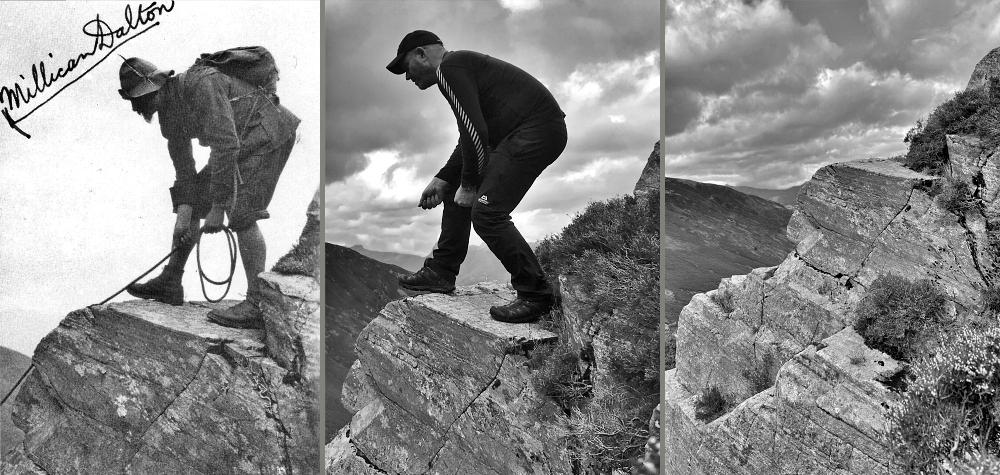
My Literary Odyssey
If you would like to discover more about my work or the history behind my books, have a look at my blog. It contains personal stories, opinions, and experiences that chronicle my journey over the past three decades.
It’s a thought-provoking account that emphasises how my initial quest for information developed into a literary odyssey; one which drew me into the same circles as authors, actors, and luggage manufacturers; broadcasters, musicians, and mountaineers; and into the lecture circuit, book awards and exhibitions.
By sharing my experiences, I aim to provide a useful source of information for Lake District enthusiasts and booklovers, and to inspire other budding authors and publishers in a way that is engaging and easy to read.
Enjoy!
Country Walking Magazine features the Skiddaw Hermit!
Last month, I had the pleasure of being approached by Nick Hallissey, the Deputy Editor of Country Walking Magazine, the UK’s bestselling publication for country walkers. Amidst kit reviews and pull-out route cards, the magazine showcases the finest walking routes and trails across the UK, including lesser-known gems.
Nick’s proposal centred around Dodd Fell, a less frequented peak with remarkable accessibility and stunning views across Derwentwater and Bassenthwaite Lake. As a favourite of his, Nick planned to craft a six-page, full-colour feature on Dodd Fell, ensuring it wouldn’t be complete without a nod to its one time resident, the legendary Skiddaw Hermit, George Smith.
During our Zoom call, Nick shared his enthusiasm for Skiddaw Hermit: The Struggles of George Smith, a book he’d already purchased. He praised the captivating story and admired the prose. Our conversation delved into my interest in George Smith, how I first came across his story, the book’s origins and compilation, and the sensitive way in which I connected George’s story to the modern-day context of mental health.
I’m thrilled with the resulting article, which seamlessly weaves between Dodd Fell’s descriptions and the intriguing tale of the Skiddaw Hermit—a quintessential Lake District legend. The piece includes striking book cover images, a link to my website, and a gracious mention of my other works.
Don’t miss the July 2024 edition of Country Walking Magazine, available in both print and digital formats. Grab your copy at www.countrywalking.co.uk or any good newsagents.

Mastermind 2023/24: Episode 22
I always raise a smile when one of Mountainmere’s products turns up in the most unlikely place.
On this occasion the unlikely place in question was on the BBC’s classic, long-running quiz show, Mastermind. Dan Hudson, a Local Government Manager, took to the famous black leather chair under the glare of the spotlight and under the pressure of a ticking clock, hoping to become this year’s Mastermind champion. His specialist subject? The life and works of Alfred Wainwright.
Faced by presenter, Clive Myrie, one of the BBC's chief news presenters and correspondents, Dan made an average start. Nonetheless, he showed his knowledge of Wainwright on Question 7 when Clive asked:
“Wainwright provided the illustrations for Scratch & Co., a children’s book about a great cat expedition of Scafell Pike; written by which author?”
“Molly Lefebure,” replied Dan confidently. Good man!
Inadvertently providing publicity for Molly’s iconic book, a pleasant boost in sales followed. What’s not to like? Thank you Mastermind!
Mountainmere: Celebrating 20-years of Great Books
This month marks the 20-year anniversary of Mountainmere, and to commemorate the occasion I feel the urge to write about the events before and shortly after its foundation; these highlight the contributing factors which led to my transition from reader to publisher. This was a hedonistic 5-year period; one in which employment was placed firmly in the back seat to allow me to follow my passions, reassess my career path and put life into perspective. I have already detailed parts of this journey, and this post will plug the gaps in the narrative.
After first becoming aware of Millican Dalton in 1996 and pursuing some background reading, in 2000 my research began in earnest. At this time, I was working a three-day weekend shift at a polystyrene packaging factory which gave me four free days per week. The work itself was mind-numbing, but I used the freedom to conduct my research and travel around the UK, all done without a care in the world. I visited huge swathes of the country and covered thousands of miles; one week I would be in the Outer Hebrides, and the next in Dorset. It was a wonderful combination of work and pleasure, and once the day’s research was completed, it was playtime. In rural areas I would pitch a tent or bivvy in the most scenic spot I could find, and in urban areas I often ‘slept rough’ in bus shelters, seafront pavilions, or on park benches, railway platforms and under bridges. Not only was this adventurous, but it was also a way of saving money for other activities.
On one occasion I flew from Land’s End to the Isles of Scilly with a friend, where we cheekily pitched a tent on the village green in the heart of Hugh Town on St Mary’s. The next day, after leaving our rucksack against the door of the local police station whilst we went exploring on Tresco, we returned to be quizzed by the island Bobby. “You can’t leave items here, it’s a security risk. Did you camp on the village green last night?” said the officer. There was no point lying, so I simply admitted “Yes.” “That’s very naughty, very naughty indeed” were the officer’s exact words. Hey-ho!
On another occasion we spent the night on Torquay promenade and, after getting friendly with the local homeless, enjoyed a couple of ciders with them (the same people we had seen drunkenly bouncing around the resort and begging for money during the day). Not one to judge, we went to the car for our camping kit and on our return laid out our sleeping bags in one of the shelters. I was woken in the early morning by a guy named Rocky who was tapping on my arm. “Hey Skin! Skin! You’ve left your can of cider,” he said, “do you mind if I have it? I thought I’d ask, as we don’t nick off our own.” I didn’t bother correcting him. These types of adventures provided the perfect work-life balance.
I initially had no intention of writing a book, but in early 2002 as my research material multiplied, I had a eureka moment when I realised there was enough content for a biography, and this became my focus in life.
There was a pause in my research for the summer of 2002 when I was made redundant, after which, along with a couple of friends, we seized the opportunity and went to live in a tent at Sennen Cove, a beautiful sandy bay near Land’s End in Cornwall. We worked at W. Harvey & Son’s fish processing plant in Newlyn, shelling brown crabs and eating Cornish pasties every day for lunch. Each evening after work we would drive back to Sennen and walk along the beach, stopping off for a pint or two at the Old Success before returning to our tent. It was rinse and repeat. At weekends we would dive headfirst off the cliffs at Piskies Cove, walk along the South West Coast Path, bodysurf at Whitesand Bay or travel to Penzance, Newquay, or Looe for a couple of nights on the pop. It was a wonderful time, most of which was spent outdoors; we were free as can be! However, it wasn’t all fun and games and, as you can imagine, three guys living in a tent for five months was far from ideal and we ended up falling out more than once.
As the season ended, we returned home, and then in June 2003 I moved to the Lake District to complete my book. Weirdly inspired by the lifestyles portrayed in Jimmy McGovern’s TV drama The Lakes, I took up a live-in position in the kitchens of the Lindeth Howe Country House Hotel in Bowness-on-Windermere and used the time between split-shifts to write; often outside amongst the fells such as on Post Knott or at my computer in the staff digs. I would spend the rest of my time partying at the Stags Head and Wheelhouse or swimming, mountain biking and wild camping wherever took my fancy. Late nights and early mornings followed by scrubbing pots and pans for ten hours was hard work, and the £4 per hour was verging on slave labour, so I chucked in the job and moved on. Positions were very easy to find, and you could quit a job on a Monday evening and start a new job on a Tuesday morning.
My partner at the time, a Sydneysider, returned from a few months at home on a family visit, and we then relocated to the Montclare Guest House on Crag Brow where she had a live-in position. The place was handy for the services in Bowness, but the noise from vehicles and late-night revellers was unbearable. Moving on once more, nomad style, we found lodgings in The Hollies on Hazel Street, Windermere. This was shared accommodation within an old cotton merchant’s house, and we had a room on the top floor with amazing views over the rooftops to the Langdale Pikes, Claife Heights and beyond—it was a perfect spot for creativity. Settled, we spent our spare time between walking around the Lakeland valleys, boating, and passing evenings at Millerground on the lake shore where we would enjoy a couple of beers and a meal cooked over a campfire; and night’s out in Windermere’s Queen’s Hotel and Grey Walls, or Bowness’s Bodega and The Hole in t’Wall.
I was then offered what I considered to be the perfect job as a warden at the National Trust’s Low Wray Campsite, but, unwisely, I chose to work behind the bar at the Kirkstone Pass Inn because it offered a whopping 50p per hour more. On my first day I arrived as planned at 10am and knocked on the door. Left waiting I almost walked away but in need of employment I continued to wait. Ten minutes passed before a small child answered the door and said “Mum is still in bed, she said you can come in.” The bar was a bombsite: dirty plates and glasses galore. I once again thought about walking but eking out every inch of patience, I stayed put. At 11am the landlady emerged and asked, “Can you take my daughter to school?” which was six miles away. Slightly shocked I said “OK,” thinking it would be in her car…but no, I was expected to act as taxi driver in my own vehicle. Journey completed I went back to the bar and proceeded clear the bombsite and serve the odd passing customer. The place and its atmosphere were grim, and I never returned the next day…in fact I didn’t even bother asking for my pay. The inn is apparently haunted, and its true! I saw plenty of headless pints!
Next up was a cleaning job at Booth’s supermarket in Windermere. This was a part time job but one that almost paid double the minimum wage, and with a 10am finish the extra free time allowed me to finalise my work ahead of publishing. Hearing of many authors and their multi-year struggles with sourcing a publisher and securing a book deal; and of tales of authors who had signed a deal only to lose control of their work, I decided to establish my own publishing house. This became a pivotal moment. Maintaining full control of all decisions was a priority and as a result, confident in my own ability, in February 2004 Mountainmere was born.
With a finished manuscript, titled Millican Dalton: A Search for Romance & Freedom, I visited Alan Hankinson in Keswick and passed him a copy to read and check. Given his age, I think it was a little much for him and he gave me the manuscript back unedited. I proofread it myself and then looked for a typesetter, selecting Indent Ltd of Kendal. They worked hand in hand with printers Titus Wilson, also of Kendal. Both businesses helped immensely and within a month the first print run of 500 books were ready for collection. By then I was working in the First Floor Cafe at Lakeland Limited in Windermere, and I popped out of work and went to collect them, returning to work once the books were taken home. It was a monumental day.
The days and months that followed were dedicated to publishing—press releases were sent out, a marketing campaign initiated, and publicity copies distributed—and I was quickly inundated with orders. Book deliveries made in person ensued, along with exhibitions and interviews. Living in the Lake District, my main market, allowed me to keep a close focus on the bookshops and restocking was easy. I managed to maintain a close, personal relationship with the owners who were fully supportive. It was a dream start for a fledgling independent business.
Tired of washing pots, I moved on from the First Floor Café and then had a couple of temporary jobs—as night porter at the Langdale Chase and an attendant at the garage in Troutbeck Bridge—before securing a decent position at Windermere Service Station in the centre of the village, just two minutes from where I lived. The owner, Chris Simpson, was a good guy and I enjoyed working there. He bought a crazy, pumped-up Toyota Hilux to irritate the Lake District National Park Authority who, in alliance with other parties, had imposed the 10mph nautical speed limit on Windermere in March 2005. Chris considered them personally responsible for curtailing his enjoyment of waterskiing and powerboating on the very lake he had frequented for decades. Chris had been part of the bitter 8-year campaign against the ban, so had his reasons for being aggrieved. I liked his style. It was a very social place to work and with tourists and locals calling in I spent a great deal of time chewing the cud with them. There were perks, too, and in the quiet times I worked on my lectures, book promotions and advanced my vision for Mountainmere.
At the end of 2005 I left the Lake District having met a wide range of colourful characters and with more knowledge than when I arrived. The high cost of living and the poor wages made life relatively difficult; and on departing I went exploring the east coast of Australia. My career path and perspective on life had been moulded in a way I could have never imagined, and I wouldn’t change a thing. You may gather that anyone can write, publish, and promote a book if you have the passion—whatever your background.
Since then, Mountainmere has performed well, fortunately managing to withstand the passage of time, and changing markets (have you noticed how many bookshops have closed?), whilst other larger publishers fell by the wayside. This is testament to readers who have shown their support by purchasing my products and to them I owe my lasting gratitude.
Here is to another 20 years!
The Wainwright Aficionado
Cast your mind back to 2021 and you may remember I celebrated the 15th anniversary of the launch of Scratch & Co. The Great Cat Expedition: an event which took place on Scafell Pike securing the credentials of England’s Highest Book Launch. To create wider interest, I contacted Chris Butterfield of Alfred Wainwright Books & Memorabilia (www.alfredwainwright.co.uk) who has earned himself the well-deserved title of Wainwright Aficionado.
My email piqued his interest and we spoke at length over the phone about our work, books, Wainwright, and Molly Lefebure. We agreed to collaborate, and Chris kindly posted a blog article I had written on Scratch & Co. and my friendship with Molly on his website.
From our conversation it was immediately obvious that Chris, like me, is totally dedicated to his cause. A deep interest in your specialist subject can grab you and consume your life. It can be exhausting gorging on your interest; you find yourself forever looking for more information, but the passion provides the necessary rewards and finding new material is like striking gold.
Chris’s efforts are highly commendable, and I want to acknowledge and help promote his work with this blog entry because without this level of dedication our shared history can be lost. Make no mistake, once it’s gone it will be lost and forgotten.
Over the years Chris has invested a great deal of time and hard-earned cash compiling a collection of Wainwright memorabilia and books that is second to none. Specialising in the publishing and printing history of the celebrated fellwanderer and guidebook author, he has unearthed a wealth of information featuring rare items and previously untold stories, which unlike some collectors, he is happy to share via his social media platforms and website. Assisted by his wife Priscilla, he has accumulated what is probably the largest collection of material held in private ownership. Despite this Chris sees himself as a custodian rather than an owner. It’s an honourable approach.
As a Wainwright fan I regularly touch base with Chris’s website to check for updates, and, if you have an interest in AW or the Lake District, I recommend you do the same. He also writes articles for magazines and newspapers, so keep an eye open for these. With Wainwright archives in mind, I felt compelled to search the catalogue of the Cumbria Archives Service and was delighted to discover that within their storerooms they hold two of my letters to Betty Wainwright. The first requests permission to use AW’s artwork for my reprint of Scratch & Co. (Ref: WDAW/6/5/1/44) and the second (Ref: WDAW/6/5/1/45) thanking her for granting permission. It was humbling to know that part of my own legacy was safely conserved within the Alfred Wainwright Archive (Ref: WDAW) along with other correspondence between AW and Molly concerning Scratch & Co. I also felt a sense of pride that Betty deemed the letters important enough to keep. It’s the little things in life that are important, right?
Chris carries the torch and is now the number one authority on Alfred Wainwright. With a view to preserving history, anyone with anecdotes, personal letters or other unpublished literature should contact him for a chat so that the existence of the material can indexed.
Our collaboration sees Scratch & Co. The Great Cat Expedition made available to purchase on Chris's website, along with other classic Wainwright titles, at https://www.alfredwainwright.co.uk/product/scratch-co-the-great-cat-expedition-2006/

Recreating an Iconic Scene
An interesting item was put up for auction on eBay in July; a family photo album belonging to Dr Alfred Gaunt Gamble of Elland, Yorkshire. Gamble died in 1962 and the album must have been handed down through his family until it was purchased as part of a house clearance. What made this album special were the numerous period rock climbing and camping photographs of his family holidays in the Lake District during the 1920s. Whilst they alone may be of no real interest to a wider audience, among this collection were several photos showing Millican Dalton, who had clearly accompanied the family on their excursions to the Bowder Stone, Coombe Gill, Easedale Tarn and Helm Crag. After a week of waiting, and some chaotic last-minute bidding, I managed to secure the album for my own archives. Obviously in demand, it cost me a small fortune. Not to worry, money is made round to go round, as my uncle used to say!
Once received I carefully inspected my prize purchase. Ralph Mayson, of Mayson's Photographic Emporium in Keswick, was the man behind the camera. Each photo in the album was embossed, annotated with a date and placename, and some had additional details on the reverse. Included was a snap of Millican belaying on a pedestal of rock; it's his most famous photograph; you will have seen it. For years, as mentioned previously in this blog, when in Keswick I always headed to George Fisher to look at a copy displayed in their window, pondering where this photograph was taken. Well, in this album, my query was answered—to a degree. I had the mountain's name, but no exact location. Bearing this in mind, I thought it would be a good excuse for an expedition.
Heading to Keswick with my rucksack packed for an overnight stay, I parked up in the Borrowdale Valley and set off with a copy of the photo in one hand and a pair of binoculars in the other. There was just one problem: there is a considerable amount of rock in the Cumbrian mountains, and the chances of finding the location was like looking for a needle on Haystacks. What, in theory, seemed a good idea from the comfort of my sofa, was, in all reality, a geological challenge. Undeterred I proceeded to inspect every rock outcrop in sight. To no avail, I headed to the summits, where I figured I had gone too high. Continuing, I followed the well-defined track which descended towards a formidable crag (sorry about the secrecy, I will disclose the exact location one day). With the panorama of Derwentwater and Borrowdale matching the landscape on the photograph I knew I was closing in on my destination. My mood quickly changed from one of doubt to excitement.
Down below, a short pitch of stepped rock came into view, and at that point I was assured I had found the erstwhile unidentified spot. Carefully making my way off-track, over rough ground carpeted in purple flowering heather and fruiting wimberry bushes, I dropped my rucksack and… went to stand aloft Millican's rock pedestal. I had found it! It was impossible to resist recreating the iconic scene from the Millican's photo, so I set the timer on the camera, struck a pose, and said "smile." Bearing in mind the rocks exact location away from any discernible path, I would hazard a guess I was the first person to stand there since the original photograph was captured. Photographs and journal notes taken; I found a place to camp for the night overlooking the Jaws of Borrowdale. A celebratory cup of tea and an hour listening to the buzzards soaring above preceded dinner before I settled down for the night.
Rising early, the next morning I headed to Millican's Cave, intent on inspecting the cave walls for an inscription that was highlighted in a newspaper article from the 1930s. Mission accomplished I made a pot of tea in the "Attic," and reflected contentedly on my discoveries.
SECOND EDITION - Millican Dalton: A Search for Romance & Freedom
Today marks the launch of the Second Edition of my biography Millican Dalton: A Search for Romance & Freedom (ISBN: 978-0-9547213-2-9). It is almost 18 years since the publication of the First Edition (ISBN: 978-0-9547213-0-5), and the book has seen a great degree of success with thousands of copies sold. In stark contrast, I clearly remember ordering the first 500 copies and questioning whether I would ever sell them. Within a month I had my answer, and I ordered a reprint.
Since then, I have received a considerable amount of feedback from readers who have shared their own anecdotes, photographs, and information. Paired with my own ongoing research, this enabled me to collate a significant amount of additional material which has formed the enlarged Second Edition. I started to compile the material in December 2020 when the ongoing covid restrictions, a period of unproductivity, provided the perfect opportunity for creativity. The result is a book containing 78000 words, 295 pages, 143 photographs and illustrations (the majority of which were previously unpublished) and a full colour cover created by Ben Edwards Illustration.
Adopting modern publishing methods, the books are now printed using on-demand technologies allowing the purchasing, printing, and distribution to be executed from within countries around the world. Reducing lead times and shipping costs, this has proved cost effective for the customer.
I would like to take this opportunity to thank all my readers for their tremendous support. My aim is to build on the successes I have already achieved and look forward to the book reaching a new generation of readers.
THE CRUX >>
Millican Dalton: A Search for Romance & Freedom.
- Second Edition
- 295 pages
- 143 photographs & illustrations
- Perfect bound paperback
- ISBN13: 978-0-9547213-2-9
- Available worldwide.
- £13.99 (or national currency equivalent).
The only biography of Millican Dalton #BeFreeBeMillican
Countrystride Podcast
I always like to be contacted out of the blue, there's something exciting about it. I also like to collaborate (a term I use often), and to be invited to be involved in subjects close to my heart. I've had many of these experiences over the years, but this is immaterial, and when I was contacted recently my excitement was still provoked.
The latest contact came about after Chris Butterfield of Wainwright Books & Memorabilia had forwarded my details to David Felton, founder of Inspired by Lakeland (www.inspiredbylakeland.co.uk) and the producer of the Countrystride series of podcasts (www.countrystride.co.uk), who initially sent me an email invite to talk about Millican Dalton. I instead proposed to talk about my book Skiddaw Hermit: The Struggles of George Smith, but David thought this might be a little dark, and wanted something a little lighter to brighten up the winter days for his listeners.
My acceptance was followed by a comprehensive agenda created by David which he had created from his copy of Millican Dalton: A Search for Romance & Freedom. The plan was set for us to follow in the footsteps of one of Lakeland’s greatest characters—and neglected icons—the self-styled Professor of Adventure. Mark Richards (www.markrichardswalking.co.uk), author of the acclaimed Fellranger guides and a linescape artist in the mould of Alfred Wainwright, would act as interviewer and David would be responsible for the sound recording. This, if you are aware of the Countrystride podcasts, is their usual format; one that has garnered an impressive audience.
On 15 January 2022, leaving my car in Stonethwaite, I made the short walk to our pre-arranged meeting point at the car park in Rosthwaite where David and Mark were waiting. I reintroduced myself to Mark as it had been 17 years since we first met at the 2005 Lakeland Book of the Year Awards where we chatted over a glass of fizz before the ceremony began. He was an upbeat, jolly soul then, and he was just the same after all those years. David was equally pleasant, and we chatted briefly about the day ahead.
We left the car park and village hall behind, and we first stopped off at Yew Tree Farm with a plan to stop at other points along the way intersecting the walk with interviews. Our first discussion was about Dalton’s early life and his family’s decision to quit the wide-open spaces of Nenthead for the London smog. Conversations relating to my work, including the subject of Molly Lefebure and the republishing of Scratch & Co. The Great Cat Expedition filled the gaps between interviews. The process was incredibly well planned, and it was clear that David had done his homework. Continuing on past Yew Tree Farm, we followed the path deep into Millicanshire, otherwise known as Wainwright’s ‘loveliest square mile’ or the Jaws of Borrowdale, walking parallel to the River Derwent and crossing at New Bridge before ascending the south-side of Castle Crag and up past the mine workings to the summit.
There we paused for breath and admired the 360-degree view, along with many other hikers who were making the most of the dry weather. Mark’s commentary on the summit proved his knowledge of the Lake District—its history and topography—is unrivalled. His descriptions of the panorama were a delight to witness; the names of mountains rolling off his tongue one by one in perfect sequence. Continuing the interview, we discussed Millican’s exit from the rat race and his establishment as a mountaineering guide, his subsequent promotion of adventure holidays where he pioneered mixed-sex camping parties and the role he played in the development of lightweight camping equipment.
Mark then said “Ok, I think it’s time to visit the cave. I’ll let you lead the way.” Rather than retrace our route back down to the Rosthwaite to Grange path, I thought I would inject a little adventure into the walk à la Millican Dalton, and taking the initiative I suggested an alternative course off the beaten track down the east-flank direct to the cave so we could leave the crowds behind. It’s a challenging descent, yet despite the rough terrain and huge number of fallen trees Mark did exceptionally well, and you would never guess he is a septuagenarian. Passing directly under the crag, we descend on the cave, where we entered and continued the interview. This provoked interest from startled hikers who arrived at the cave for a look around. Mark was quick to introduce us and passed on his business cards informing the hikers of our purpose and asking them to tune into the forthcoming podcast. From there we proceeded to the side of the River Derwent at Low Hows Wood and halted on the pebbled bank for the last interview segment before David and Mark went to meet their lift at Grange-in-Borrowdale and I made my return to Stonethwaite.
David’s resulting podcast is a professional, high quality and beautifully edited production. His clever use of ambient sound coupled with Mark’s cheery tones and exquisite descriptions enable the listener to transport themselves directly into various scenes.
On the day the podcast was published online, my partner and I listened during a journey to Glenluce in Scotland, and it certainly made the long drive more enjoyable. I recommend you too join the Countrystride podcast and follow in the footsteps of Millican Dalton. I will certainly look forward to the next person to contact me out of the blue!
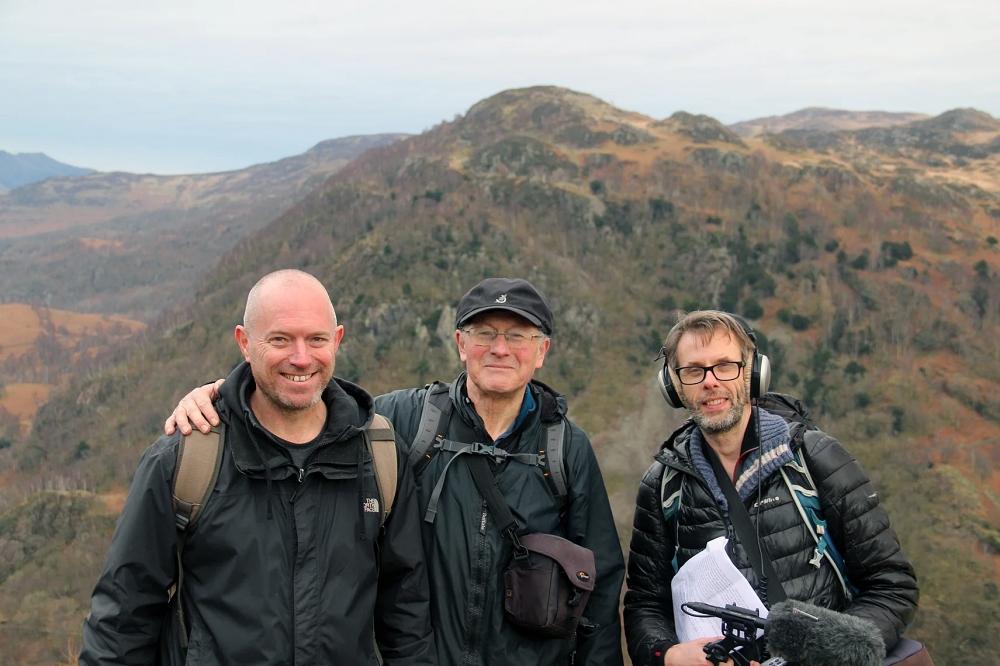
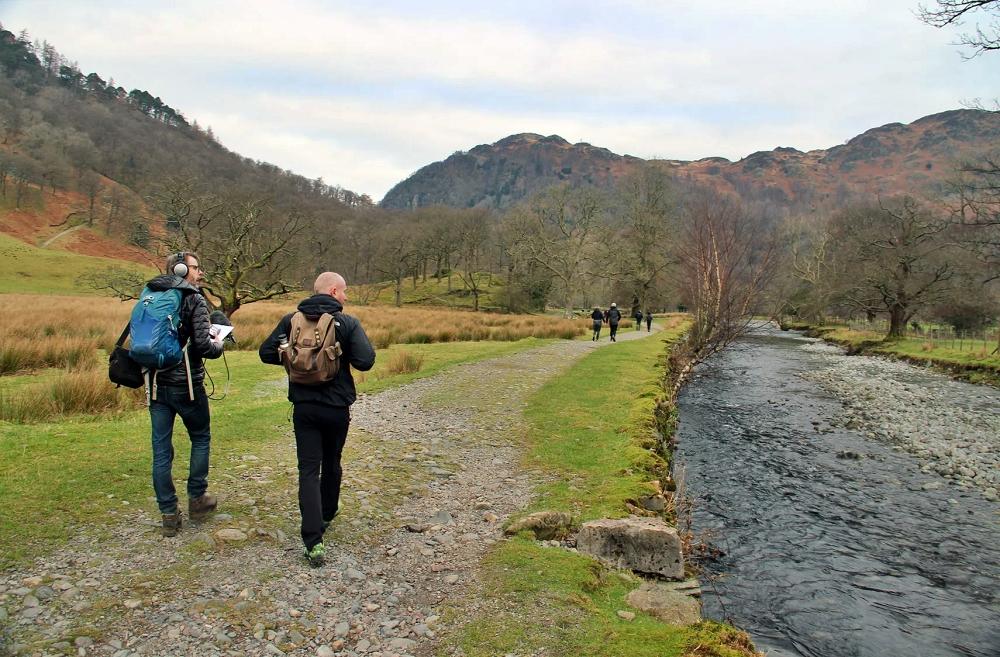
Luggage Firm Packs-up
The devastating effects of the Covid lockdowns on small businesses has taken its toll on Lake District based Millican Ltd. Restrictions on retail opening and curbs on their core customer base traveling has had a detrimental impact on the business’s fortunes, which went from a two-person operation into a global brand. Having spent several years dealing with Nicky and Jorrit from the inception of Millican Ltd, their entrepreneurial skills were evident. With a business acumen honed in previous high-flying roles, their passion for their products and a clear understanding of their market led them to produce exceptional marketing campaigns, branding, newsletters, beautiful photography, high quality promotional films and collaborations. Additional to their superior customer service, they provided high quality products to last a lifetime.
Millican Dalton was their inspiration, and building on his ethos of sustainability, recycling, and minimalism, had a target audience amongst eco-friendly shoppers. I had collaborated with Nicky and Jorrit and my book, Millican Dalton: A Search for Romance & Freedom (which they had read and used as the inspiration for their brand) was used to help drive sales; copies were made available for purchase through their website and stockists, and used as props for their quirky retail displays.
Millican Ltd went into administration on 1 February 2021. Whilst the brand was salvaged, the association with its namesake, Millican Dalton, was dispensed of in favour of a marketing push towards fashionable, urban gear. It is now a brand devoid of its founding connections and has lost its unique identity. Reincarnated by Millican Outdoors Ltd, the brand has been relocated from The Shed in Braithwaite to Withington, Hereford (www.homeofmillican.com).
Will Millican survive in a highly competitive market without their back-story? Only time will tell.

Feline Good with Lord of the Lakes
Fifteen years ago today I relaunched a Wainwright illustrated title at an event quite unlike any other. In this blog post I recollect my story of a hobby that has turned into a literary odyssey.
Hailing from the same town as Wainwright, I have upheld a longterm interest in the local heritage. In addition to our connections with the cotton trade, as a community we are also proud to be home to the birthplace of Alfred Wainwright. I was first introduced to AW through my dad, a keen walker and owner of the Pictorial Guides, and in the 1980s we used them to explore the Lakeland Fells together. Subsequently, Wainwright calendars and diaries, received as Christmas presents, and my passion for the Lake District, moulded me into a fellow 'Fellwanderer.' Thereafter, during the early 1990s, I commuted past AW's erstwhile home on a daily basis, each time taking note of the blue plaque on its frontage dreaming of one day following in his footsteps and relocating to Cumbria.
Fast forward to the year 1996 and Wainwright again featured as a positive influence. On this occasion it was a page in Book Six, The North Western Fells which was brought to my attention. It detailed a 'Professor of adventure' who lived in the quarried caves on the eastern flank of Castle Crag in Borrowdale. Initial background research into this character, better known as Millican Dalton, resulted in me fulfilling my dream and establishing a home in Cumbria. There I paid my way by working in the kitchens of Windermere, and in my free time I wrote, then published, my first book: Millican Dalton: A Search for Romance & Freedom; a book that has seen a great deal of success. Thank you for the inspiration, Mr. Wainwright!
The following decade, and with the centenary of Wainwright's birth approaching, I contemplated what I could do to commemorate the milestone, and highlight his celebrated links to Blackburn. Yes, I hear you say, there was already the blue plaque, a legacy with Blackburn Rovers Supporters Club, and his connections with the Town Hall; but at that time there was nothing else to officially acknowledge him as a son of our town—no Wainwright Bridge, Thwaites Wainwright Golden Ale, Wainwright Monument at Pleasington, or Wainwright Way orbital road. This led me to develop the idea of a Wainwright Centenary Trail which would take in relevant sites around Blackburn, and so, in early 2006, I approached Blackburn with Darwen Borough Council. At that point they showed no interest in creating a permanent trail or acclaiming AW's centenary in 2007, but we agreed to undertake a joint venture—a guided walk around the Borough as part of a local walking festival. The walk went ahead and a group of thirty stalwart Wainwright fans met outside the Town Hall before taking in the other locations associated with AW, culminating with a visit to his birthplace at 331 Audley Range where the resident kindly invited our group inside for a look around.
Taking my plans one step further, I then considered republishing one of the lesser known books illustrated by AW, in this instance Scratch & Co. The Great Cat Expedition; a rare book and one which I thought was more than worthy of a new lease of life.
With my choice of book established, I contacted Molly directly after searching through the BT phonebook, and I was curtly directed to her agents Watson & Little; at which point I promptly made my apologies for my lack of publishing etiquette. Next I sent a letter (such a quaint act in these days of social media) to Betty Wainwright. After a couple of weeks I eventually received a telephone call during a day out in Keswick. It was Betty's carer. She had phoned on Betty’s behalf before passing the phone over. During this conversation I received permission to use AW's illustrations.
The contract negations with Watson & Little continued and I eventually signed on the dotted line. From this point forward my dealings with Molly became direct, and much more personal. Molly then invited me to her delightfully located home at Low High Snab in the Newlands Valley so we could introduce ourselves, and allow me the opportunity to scan the original Wainwright illustrations. We discussed the book's origin, which Molly told me, believe it or not, she wrote in three weeks (most of her books took years), and mentioned that Wainwright had forfeited his right to royalties; instead insisting his share should be donated to charity.
The choice of illustrator was an easy one. AW was hugely successful and, of course, as we now know, very good friends with Molly, a fellow mountaineering connoisseur—a friendship originally started by post in 1957 after she wrote to him regarding an error in Book Two, The Far Eastern Fells. They shared a lot in common, not only their love of the countryside and the Lake District—but also for cats. When asked to illustrate Scratch & Co. the pair had still not met in person. Instead Molly had sent AW a manuscript and after reading it through he agreed to provide suitable illustrations. Holding Wainwright’s original artwork was a red letter day, and a moment I remember well. I read through the letters accompanying the illustrations written in typical Wainwright humour.
Paying a visit to Kendal Library, I borrowed a first edition and typed up the manuscript. Progressing onto the book cover, I received a reprimand for incorrectly including the word 'debutants,' rather than 'devotees,' in the book’s synopsis, a genuine mistake made whilst hurriedly transcribing a telephone conversation. After being educated on the exact dictionary definition of a 'debutant' I was then told in no uncertain terms that Molly would write the synopsis herself and forward me a hardcopy. She was no shrinking violet, that's for sure; though at this point I still had no idea of who she really was.
Keeping with the pedigree of first edition I opted for the book to be typeset at Indent Ltd and printed at Titus Wilson, both of Kendal; this maintained the integrity of the book—wholly written, illustrated, typeset, and printed in Cumbria! The printing and binding ensued and David Rigg from Titus Wilson dropped off the books, 'hot off the presses,' at my home. No title such as this should be without a book launch, and that was the next consideration. You will have read elsewhere in this blog that the event took place on the summit of Scafell Pike, and took its place in the annals of history as England's highest book launch.
To set the publicity machine going full speed, I contacted the team at BBC Radio Cumbria and arranged for an interview with Molly. I collected her from home and drove to the studios in Carlisle; a day that she thoroughly enjoyed. Who can blame her? Tell me an author who doesn’t want to stay relevant!
2007 brought with it the annual Lakeland Book of the Year awards. I had entered Scratch & Co. and along with Molly attended the charity luncheon held at the Langdale Chase Hotel on the shores of Windermere. She was a well known figure among the attendees, and warmly welcomed.
Initial impressions of Molly made me think that she was rather short tempered or possibly something of a diva, but this could not have been further from the truth. Whilst she may have been a straight-talker, she was an open and welcoming person who invited my family and I into the heart of her home. Far from just being her publisher, we became friends—despite the huge age gap—and I spent many hours in her company.
We would sit in her kitchen around the Aga or in the lounge where I would listen intently to tales from the wartime years when she worked as private secretary to Professor Keith Simpson, the famous Home Office forensic pathologist. After becoming friendly with Simpson she chose to ditch her career as a London newspaper reporter to work on some of the biggest cases of the twentieth century. As the first woman in the world to work within a mortuary, she became known as "Miss Molly" or "Molly o’ the Morgue" by Scotland Yard detectives—after all she had assisted with the postmortems of 8000 corpses, many a time eating her lunch, placed unceremoniously next to those unfortunate souls, nonchalantly taking notes whilst Simpson dictated his findings. "If you can eat a ham sandwich in a morgue," she said, "you can eat anywhere."
On one visit she recollected chilling details behind the crimes of mass murderers John George Haigh, the Acid Bath Murder; and John Christie, the Rillington Place Strangler. I was even shown a black souvenir—Christie's calling card (Simpson and therefore, by default, Molly had been recruited as part of Christie's defence team). Serving justice was Albert Pierrepoint, the last hangman in Britain, who could be counted as one of her friends. Although clearly passionate about her work, something she put before romance and a settled home life, these stories were, as you can imagine, not taken lightly!
Moving on from her five-year employment with Simpson, Molly then turned author writing books in various fields. Funded by profits from her first book Evidence for the Crown, relating to her experiences with Simpson, she subsequently moved to the Lake District in 1957. She followed this with Murder with a Difference: The Cases of Haigh and Christie, after which came books on the Lake District (including Cumbrian Discovery, dedicated to Wainwright), two more novels, and writing for radio and television. Additionally, she was also author of acclaimed biographical studies of Samuel Taylor Coleridge and Thomas Hardy. Acknowledging her sterling efforts Molly was elected a Fellow of the Royal Society of Literature in 2010. Her grand finale was a third Coleridge study, Private Lives of the Ancient Mariner.
In time I learned of her six-year study into drug addiction at Guy's Hospital and more about her friendship with AW. Maintaining their correspondence by mail for 13 years, often weekly, the two of them had eventually met in person in 1970 when, along with husband John, she paid a visit to Kendal Green. Afterwards they met many times both on the fells, and at Low High Snab where Wainwright would sit on the terrace in front of the cottage in his immaculate, bright white shirts. Molly said that the many walkers who passed through her yard whilst busily reading their Pictorial Guides were unaware that the author was sat unnoticed only feet away—something said author took great pleasure in, for he was no lover of crowds.
It transpired that their friendship was something of a love-hate relationship; it was an attachment of highs and lows, of happy times and disagreements. Reading between the lines I was left with the sense that AW had a crush on Molly. On the flip side, whilst she admired his natural ability as a writer and artist, she was equally irked by his stubbornness (he always thought he was right) and a belief that he had become a Lakeland idol (I thought this was rather ironic considering there are many who do in fact consider him to be Lord of the Lakes). She was also critical of his guidebooks being of the opinion that they had facilitated the mass erosion of the high fells; his readers following his trails exactly, step by step, leading to heavy footfall in remote, sensitive areas. I was shown more letters and told more tales, pretty much as described in Wainwright—The Biography by Hunter Davies, and for this reason I will not elaborate further.
A Lake District aficionado, Molly happily relayed other stories ranging from her personal memories of Millican Dalton, an alleged explosive detonation of Broad Stand to make access easier, to her explorations of Goldscope Mine located on the fellside directly opposite her home. I can assure you all, Molly was an impressive raconteur!
Many times I was invited for lunch, and on one occasion was treated to the most delicious lamb cutlets marinated in Cumberland sauce and served with accompanying roast vegetables, after which she happily signed books for me after remarking, "I would normally have charged £10 per book, that was my usual fee. All for charity!"
As a former member of the Blencathra Hunt, Molly made no apologies for her participation, and the walls of her home were adorned with taxidermy trophies. They were not the only animals encountered on my visits, and one of the more comical episodes I experienced was the time when my dad and I were 'ordered' into position by Molly to help round up a couple of Herdwick sheep from her yard at Low High Snab along with her husband John; it was akin to a skit from Benny Hill. Though they were well into their late 80s one would have never guessed as they were both very sprightly for their age.
In her twilight years our friendship waned, and I was saddened to hear of her passing in 2013 aged 93, yet forever thankful to have know such a remarkable woman whose tales I never tired of hearing.
Latterly AW inspired me once more, and in 2019, whilst reading Book Five, The Northern Fells, I was led towards the story of the Skiddaw Hermit—a wandering artist and tormented character suffering from mental health issues who lived for a while in a 'nest' on Dodd Fell. I took up the pen and once more began writing. My second book, Skiddaw Hermit: The Struggles of George Smith, was published in June 2021. I am currently finalising the second edition of Millican Dalton: A Search for Romance & Freedom, due to be published in January 2022.
I will continue reading my Pictorial Guides using them as both an aid and for inspiration, and look forward to discovering my next project. To you AW, my fellow Blackburnian, I doff my cap! The past twenty years, for me, have been a wonderful, educational journey.

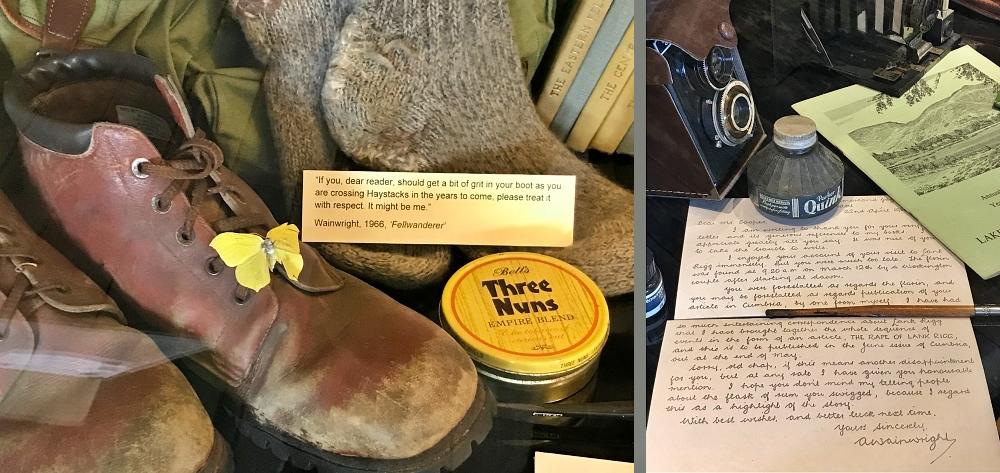
Loughton Blue Plaque
Some elements of life move very slowly, especially when it comes to the recognition of a persons achievements. It seems that there is a select group of figures who attract all the attention, and it's hard for anyone else to break into the prized circle. However, kudos to Loughton Town Council who, at the end of July 2021, unveiled their 48th Blue Plaque as part of their prestigious heritage scheme. A request from the current resident of Walnut Cottage, Stony Path, to celebrate the home's association with Millican Dalton was accepted and the property now displays the tribute, which is intended to inform the town's current inhabitants of the rich history on their doorstep.
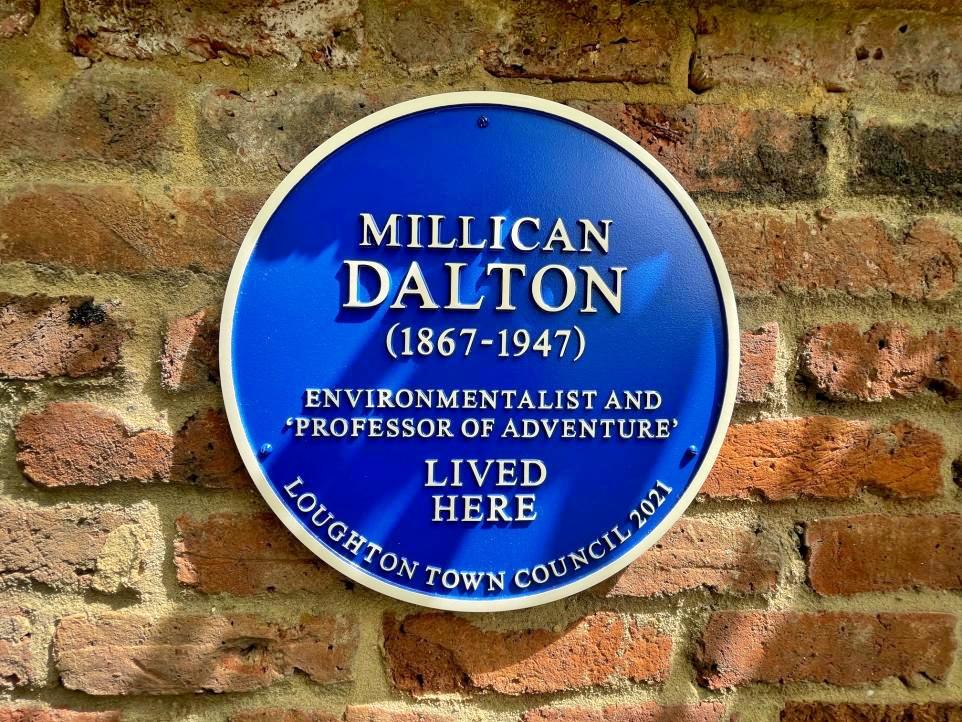
NEW RELEASE - Skiddaw Hermit: The Struggles of George Smith
It is almost 150 years since one of the most notorious characters of 19th century Britain graced the fells and dales of the English Lake District, and although he only lived in the region for nine years, he made such an impact that he was known by all. A personage unique in attire and habits, his notoriety spread like wildfire through the UK and as far a field as the USA and Australia. One may find it peculiar that a character of such fame could quickly fade into obscurity, but the release of my new book, Skiddaw Hermit: The Struggles of George Smith, will reignite public interest.
Lovers of the Lake District and the Scottish Highlands, and those with a curiosity for real-life tragedies will appreciate this gritty, tragic tale of one mans desperate desire to live a solitary life among the beauties of Nature. Thwarted by heavy-handed landowners, unsympathetic authorities and the challenges of mental health issues, his life was one of highs and lows, one of persecution and simple pleasures. A juxtaposition no one would envy.
A gifted artist, angered poet, and handy phrenologist, he left no discernible legacy, except for the well documented accounts of his struggles which highlight the need for change even in these modern times. The inequality he faced is still prevalent in society and indicate to the reader that little has changed over the centuries.
I was originally introduced to the story of the Skiddaw Hermit in A. Wainwright’s Pictorial Guide to the Northern Fells, an ever faithful source of antiquity. Subsequent studies of archived literature and field studies to photograph Smith’s portraits at museums and private residences in Cumbria provided sufficient material for me to start writing.
Written during the Covid lockdowns, a period when we all felt like hermits, the book chronicles the life of the Skiddaw Hermit in 136 pages, 46000 words, and 26 illustrations, all presented in a full colour cover created by Ben Edwards Illustration.
Adopting modern publishing methods, the book is printed using on-demand technologies allowing for worldwide purchasing, printing, and distribution. With reduced lead times and shipping costs, this improves the overall customer experience.
THE CRUX >>
Skiddaw Hermit: The Struggles of George Smith
- First Edition
- 136 pages
- 26 photographs & illustrations
- Perfect bound paperback and Kindle
- ISBN13: 978-0-9547213-3-6
- Available worldwide.
- £11.99 (or national currency equivalent).
The only biography of George Smith, the Skiddaw Hermit.
Borrowdale Gates Hotel
The family that owns the Borrowdale Gates Hotel (www.borrowdale-gates.com) have carried out a major refurbishment of the establishment through local craftsmen. Their stylish, contemporary bedrooms include a special new offering…the Millican Dalton Dulton Superior Suite. Desirably located in the shadow of Maiden Moor, the hotel is in a perfect place, for those with pockets deep enough, to look at Castle Crag and think of Millican in his own “Cave Hotel.”
In stark contrast (which couldn’t be greater), there is little to compare the suite to the “Cave Hotel” except for the rough Lakeland slate doorway with bench seat and its Borrowdale setting. Plush fabrics, comfy armchairs, widescreen televisions, king-sized beds, and porcelain conveniences were absent from Millican’s mountain retreat, and I am sure the hotel’s food offerings will be more extensive than the hermit’s menu of porridge with syrup, strong coffee, and wholemeal bread. That said, the immediate surroundings are exactly the same—beauty abounds—and with adventure on the doorstep residents can easily access the many natural attractions in Millicanshire.
Millican, who used “only the basic necessities of life,” is famous for sleeping on a springy bed of bracken with only a tattered old eiderdown quilt and a campfire for comfort, so I am not quite sure what he would have made of his name being used to promote a luxury hotel suite, but nonetheless it’s good to see local businesses making the most of the valley’s heritage.
George Fisher Window Display
For many years, on my visits to Keswick, I made a beeline for George Fisher’s store (www.georgefisher.co.uk) on Lake Road to look at an item in their window. It was an icon harking back to days of old; it was something that caught the eye of many who passed by, often accompanied by comments to the effect of “Who is that?” The item in question? A classic photo of Millican Dalton in a rustic wooden frame propped up against a vintage canvas rucksack. Then, one day on a subsequent visit, I made my way to George Fisher in the usual manner, but on arrival the photo, what looked to be a Mayson’s original, had been removed from the frame and left curl in the sunshine. I quickly asked Fisher if they would be willing to sell the photo as it deserved better treatment, but they politely rejected my offer. In the meantime, the store was sold, and on my return the photo and rucksack had been removed completely—never to be seen again.
However, not long after, Jorrit and Nicky from Millican Ltd struck a deal with Fisher to stock their bags and had arranged a window display to showcase their products. Having advance knowledge of this I went to look. And lo! the whole window in Keswick’s premier outdoor equipment store was a homage to the Professor of Adventure…sat there, as part of the window dressing was my book, Millican Dalton: A Search for Romance & Freedom. For someone who enjoys the simple things in life, this was a joy to behold and the recognition of my work, which had spawned Millican Ltd, a backhanded compliment.
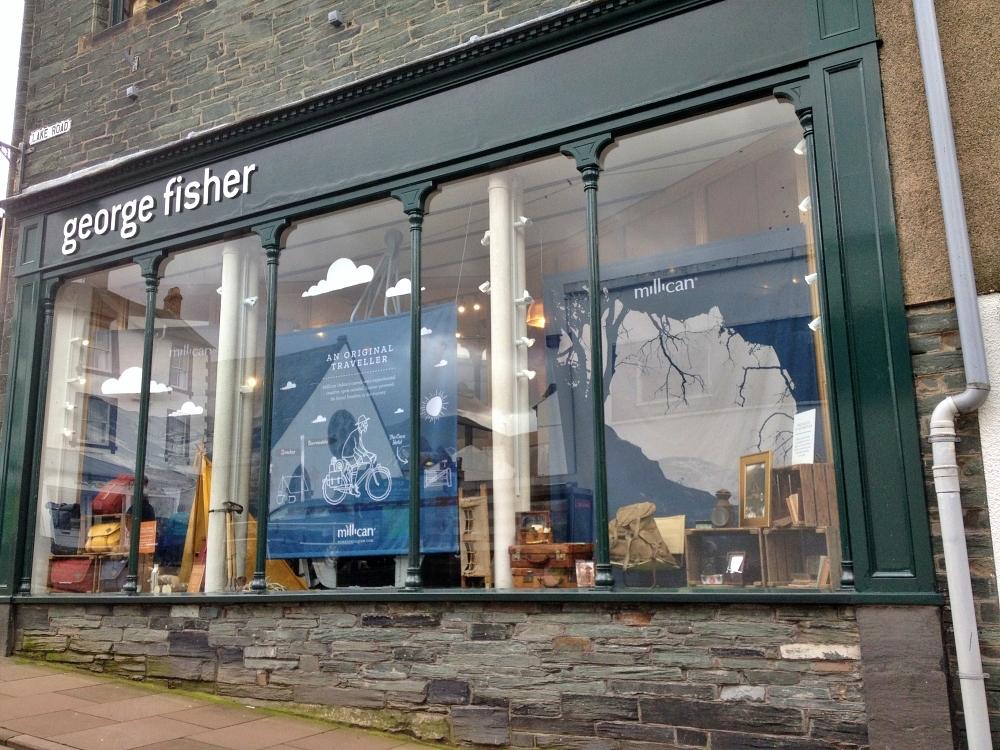
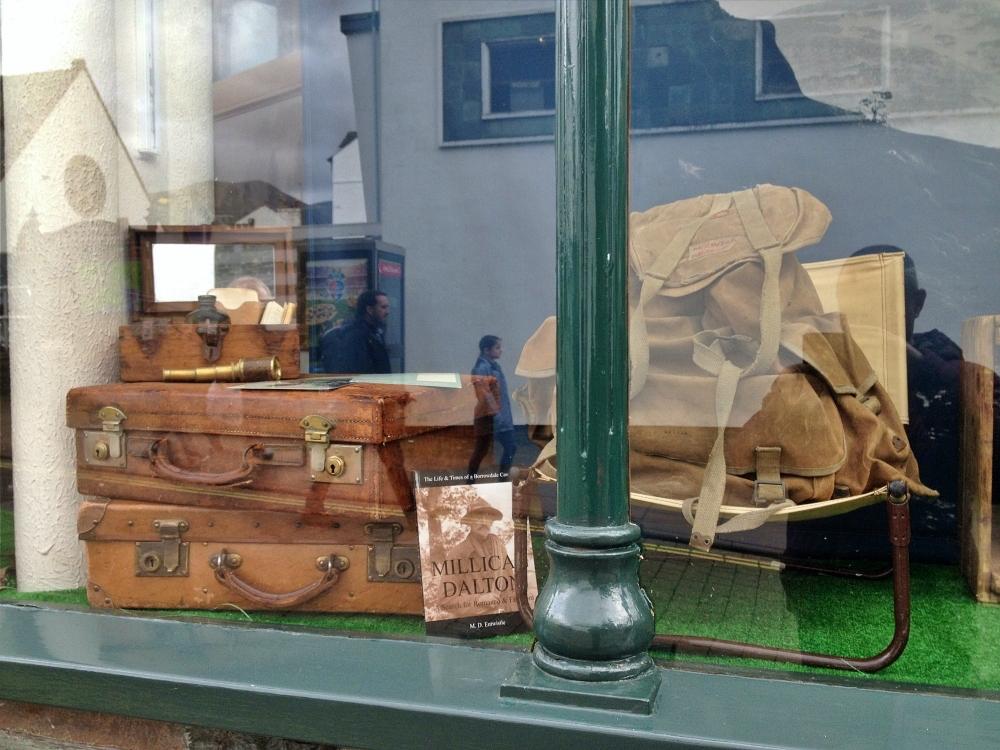
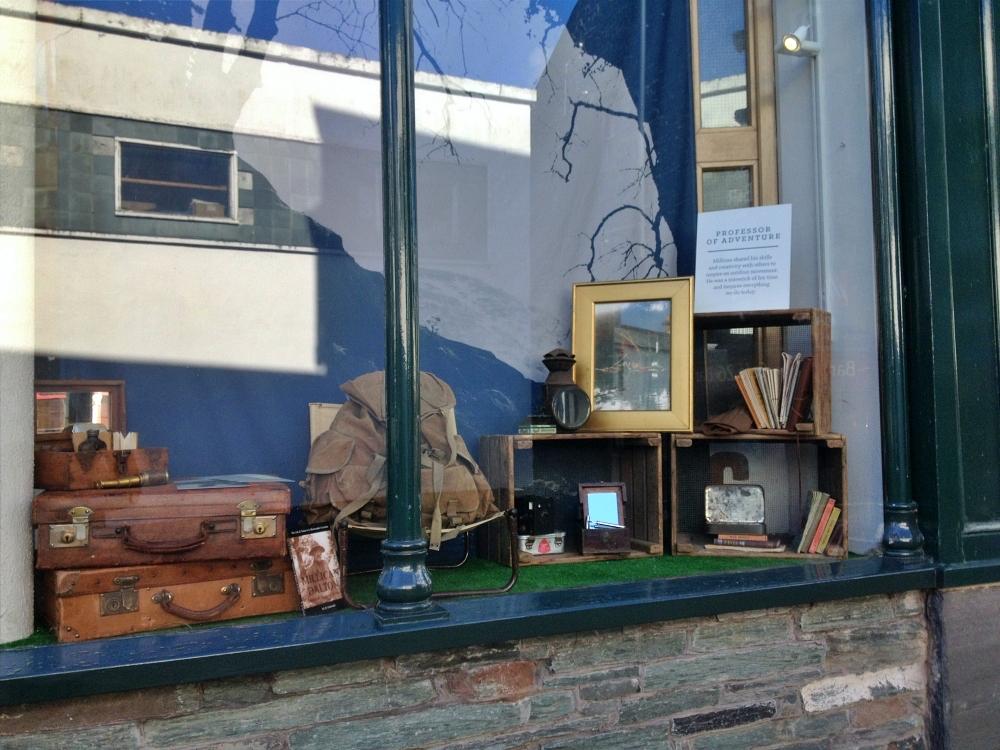
BBC1 The Lakes with Paul Rose
It would appear that once you have broken into a circle, you see just how small that circle really is. The circle in this instance is television, and once your name is on file you become a go to person. An email from the production team at BBC Yorkshire offered me an interview on a proposed BBC1 programme, The Lakes with Paul Rose. A four-part series where Paul explores some of England’s highest mountains and meets some of the folk who live and work in the UK’s most-visited National Park.
Having previously witnessed the power of the media, I quickly accepted the offer. It would come at a financial cost as in my case, as with most, there are no expenses or fees payable, but the opportunity to appear on mainstream television to promote your wares is too good to miss.
Plans made, on 11 October 2017 I headed to Borrowdale with the intention of spending a few days with a friend and taking in the interview along the way. Offering slightly more comfortable accommodation, especially during inclement weather that was forecast, we opted to stay at Dinah Hoggus camping barn in Rosthwaite the night before the interview. After torrential rainfall of biblical proportions overnight, I woke to a flooded valley. Leaving my friend sleeping, and heading out to Rose Cottage, at the side of what was Rosthwaite Stores, I was advised by locals that the road to Grange-in-Borrowdale was under water. I hastily suggested the alternative route over Honister Pass to Newlands and onward to Borrowdale, but they dissuaded me as there had been a landslip onto the road. Determined that I would not miss the interview, I attempted to make my way to the cave on foot. Foolish or dedicated? You may decide on the former when I tell you that just past Yew Tree Farm I resorted to wading through thigh-deep water and then proceeded parallel to the River Derwent.
With the river in full spate and threatening to spill out over the top of the flood defence walls, I must admit that I was a little unsure of my safety. There is a heightened sense of danger in these situations, especially when there is no one insight or to watch your back, so I was reluctantly forced to turn back at New Bridge, which crosses the River Derwent near the south of Castle Crag. In reality the bridge was no longer bridging anything and had simply become a folly surrounded by the bludgeoning river; Mother Nature had spoken and gave me no option to continue my journey. Through the flood water once more, back in Rosthwaite I fortunately managed to contact the BBC team and we rearranged for the following day. I was left feeling they must have had more sense, as they hadn’t even attempted to leave their accommodation, though I like to think they were just not as adventurous! Retreating to the barn, I met with my friend, and we went to the Riverside Bar at the Scafell Hotel where I could dry out.
If you have seen the flooding in Borrowdale, you will know that it clears as quickly as it arrives, and I had no issues travelling to the cave the next morning. On arrival Paul Rose and his camera crew were waiting and they emerged from within the cave along with actor Peter Macqueen dressed in character as Millican Dalton, who was also to appear on the interview piece. Paul was very pleasant, a man with a relaxed demeanour that put me at ease, and we chatted casually as the crew tested their equipment. We sat on the slate walls at the entrance to the cave, with a camera front and rear to capture different angles. Microphones and cameras at the ready, we commenced the interview. Thereon Paul ran though his list of questions, and I replied without too many takes. Peter Macqueen then took his turn in front of the camera. I decided to stay until Pete's interview was concluded, at which point we posed for our photograph, said our goodbyes, and went our separate ways. I returned to join my friend at Dinah Hoggus from where we continued our adventures.
The show is set to be broadcast on BBC1 Friday 27 July 2018 at 7:30pm.
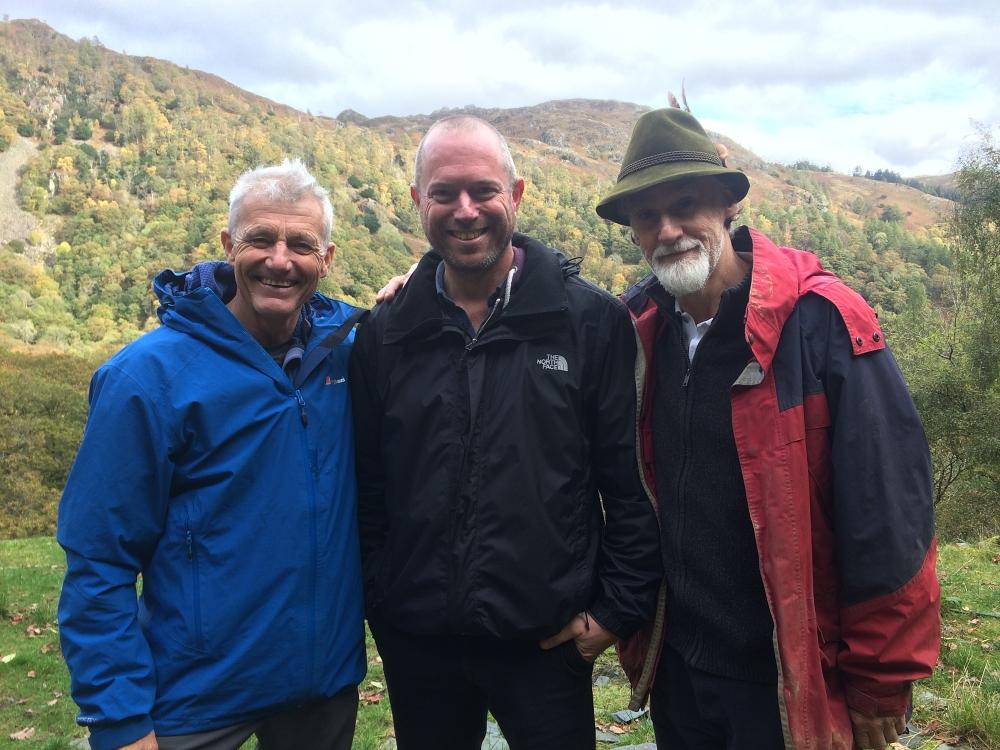
Power of the Media
Ever since the publication of my first book, I have been fortunate enough to have received publicity in various forms. Some of this was initiated by myself, whilst the remainder was through others coming across my work and promoting it themselves. Newspaper, magazine, and journal articles are all mediums that reach a wide audience; radio offers a non-visual alternative; but they have their limitations. However, we are all aware that television is a formidable advertising tool—one perceived as the most influential—and in this blog post I want to highlight the power of the media and the positive effect it can have on the successes of a small publishing house.
Following on from my Countryfile appearance in 2015, the BBC decided to produce a compilation episode of their favourite excerpts, including the one in which I was involved. Broadcast on 17 September 2017, the re-run of the piece, filmed alongside Adam Henson, proved, yet again, to be a hit with viewers. My assumption is based on book sale statistics because, following the broadcast, Millican Dalton: A Search for Romance & Freedom glided up the respective Amazon charts. As of today, 7 days after the broadcast, it ranks in the Kindle chart at #5; one position above Joe Simpson's Touching the Void. In the overall Amazon book chart, it ranks at #1792, with an impressive position of #237 in the biography category. Considering the vast number of books available on Amazon, this is an exceptional result. It’s a pity I didn’t check the stats on the day the programme was aired as the rankings would have been considerable higher. To say I am pleased is an understatement!
The moral of the story is: promote yourself, showcase your wares, send out those review copies and make every effort to secure a slot on a relevant television show. Believe me, it is possible.
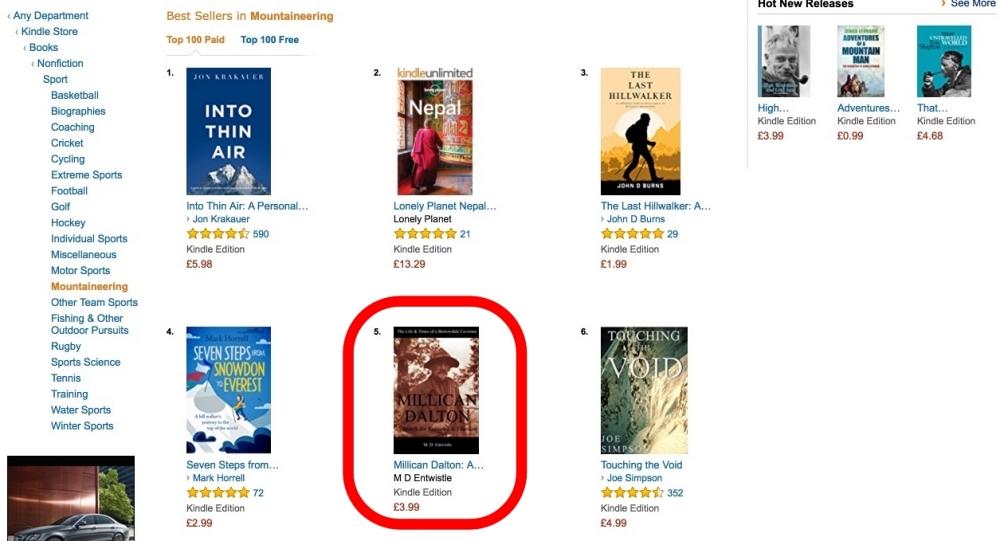

A Play on (my) Words
Last year, whilst on my travels, I had chance encounter with actor Polly Lister at Merienda, a café in Keswick, and this led to a conversation about Millican Dalton. Polly’s reaction was one of inspiration (I could see the cogs turning behind her eyes) and she immediately declared “Millican’s story would make the perfect subject for a play.” It turns out she subsequently relayed the conversation to a colleague at the Theatre by the Lake; the colleague in question was fellow actor Peter Macqueen. He then contacted me and asked whether we could meet to discuss Millican. What was an initial brief conversation with Polly about Millican in the café had morphed into a proposed play. Isn’t it marvellous how things develop? Obviously intrigued, I met Peter at the Theatre by the Lake where we chatted over a pot of tea. Armed with a copy of Millican Dalton: A Search for Romance & Freedom and notes taken during the meeting, he went away and put pen to paper. A script emerged over the next 12 months. No stranger to theatre work, or one-man plays, Peter worked with the team at the theatre to develop the set, one that would dismantle to fit in a trailer, for his plan was to take his show on the road once the performances in Keswick were finished. His play was to be titled Professor of Adventure.
Eventually, after a period of no contact, Peter was in touch once more with the offer of complimentary tickets for my family and myself as a thank you for my help. Following the plays world premiere at the Theatre by the Lake, it was set to run from 19 March to 5 April 2016. Our tickets were for the performance on Saturday 2 April, and we arrived in Keswick stopping off for a treat of fish and chips at the Old Keswickian before making the short, pleasant walk to the theatre where I bumped into the friendly staff from Bookends (www.bookscumbria.com) in the queue. Greeted with publicity posters on the pavement and in the foyer, there was a real sense of excitement. Make no mistakes, this was an eagerly anticipated show that had captured the minds of Lakeland lovers; it was a production about one of their own.
Martin Johns’s authentic set, props and lighting design were exquisite, and all combined perfectly to transport the audience into the peculiar world of a modern-day caveman. The compact, cave-like set, and nature of the studio offered an intimate experience delivering a sense of being at one with Millican. Serious in parts with intensely moving moments, the occasional injection of humour was sufficient to lighten the tone. There were flashes of Wordsworth when our character conversed with an imaginary butterfly, and in how the cascading water through the cave roof created a masterpiece of sound, and these were carefully offset with plenty of thought-provoking silences. Peter skipped Millican’s history—this was no bioplay—and focused his attention on the winter of 1940/41 when our Professor of Adventure had retreated to his cave to shelter from the arial bombardment of the Luftwaffe. Though, in equal measure, there was no dwelling on the war, just a reference to a letter that Millican had sent to his nemesis, Winston Churchill, demanding an immediate end to the conflict because they were interfering with his liberty. Proving to be a clever move, this kept the storyline relevant to Borrowdale.
There was real skill on display as Peter, acting solo and without a set change, managed to captivate the audience for two hours. It was a surreal experience to watch a performance based on my book, and by the reaction at the final curtain one thoroughly enjoyed by the whole audience. It was a night to remember, especially for me and I left Keswick on a high.
Those who missed the Keswick shows may be interested to learn that Peter has planned a one-off, on-location performance in Millican’s “Cave Hotel” in association with the National Trust; a truly unique event that should not be missed.
Theatre images courtesy of www.pmacproductions.co.uk
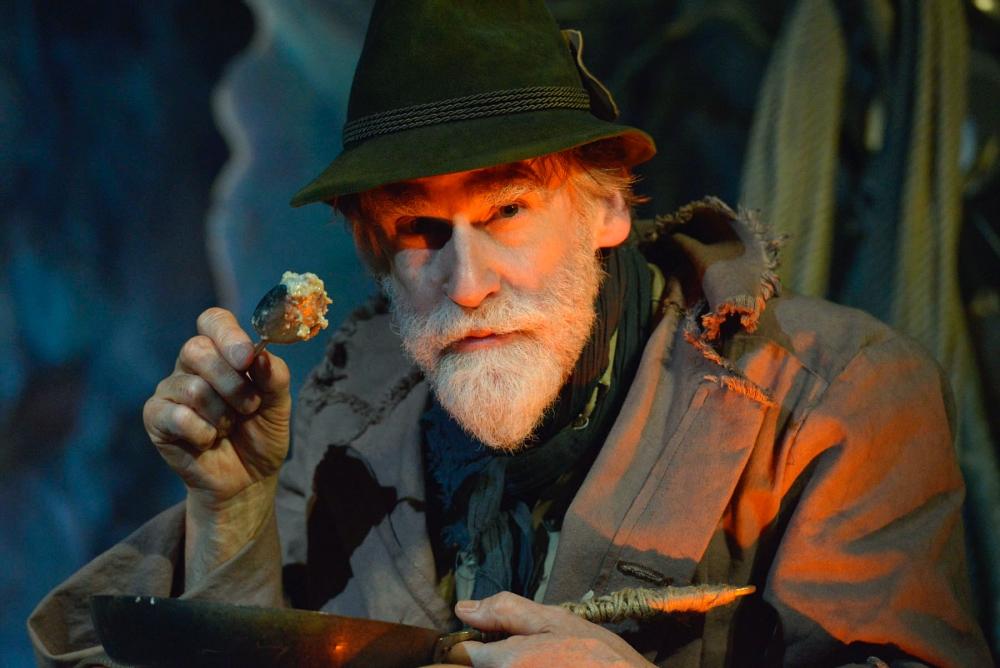
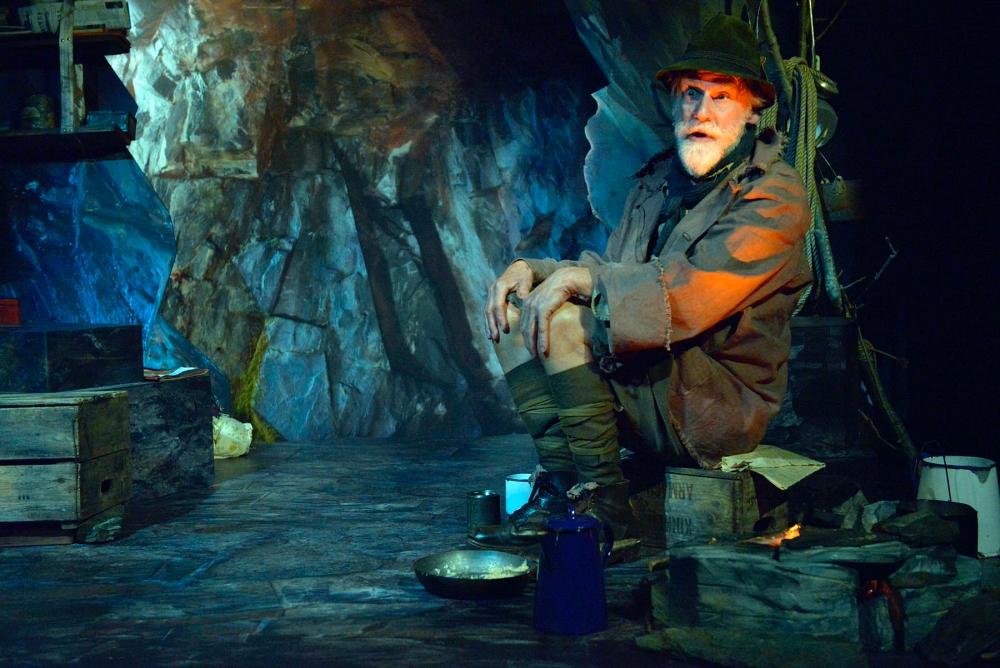
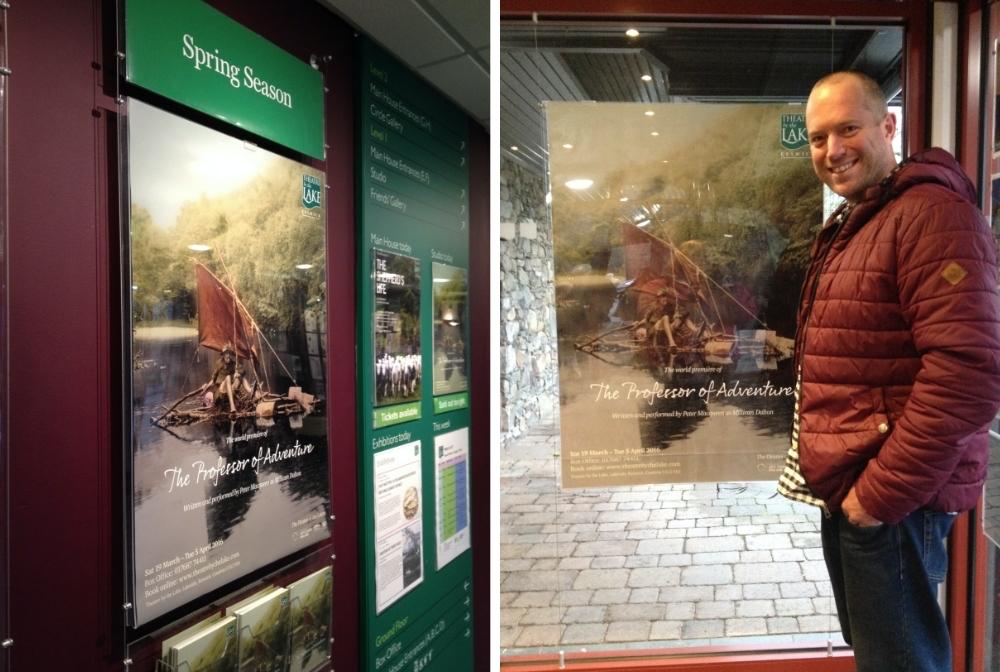
BBC1 Countryfile
Among the masses of emails we receive on a daily basis often lies a little gem. For example, in November 2014 I had a pearl of an email waiting in my inbox. It had come out of the blue from Peter Tat at the BBC who had made contact via my website asking for information on Millican Dalton; it was for a project he was working on. It just so happens that the programme was Countryfile, the BBC’s flagship programme. Following several further emails, I was subsequently invited to appear on the show.
You may be wondering why was I selected? The answer to that is very simple. The theme of their proposed show was “the great outdoors.” The countryside, as a free resource, is open for all to enjoy, and the programme looks to discover what can be done to inspire underrepresented groups and increase their involvement by highlighting past, present, and future initiatives which will encourage greater numbers to discover the joys of the great outdoors. Millican Dalton, a promoter of equal opportunities, fit the narrative—hence their wish to cover his story. As I am the man carrying the torch for Millican’s legacy, I became the go to person.
The show was to be centred in the Lake District and even though the national park ranks as one of the UK's top tourist destinations for people looking to enjoy the outdoors, few will realise that they are following in the footsteps of Millican Dalton, who introduced the first multi-activity adventure holidays for likeminded lovers of the countryside. He was the catalyst and by teaching others a wide array of skills enabled them to enjoy the outdoors. There was a clear push from the BBC towards Millican’s egalitarianism and the women he inspired to get involved in outdoor pursuits. Although women taking part in outdoor sports is far from a new phenomenon, it is currently an on-trend topic and one that the BBC champion. They wanted to show how his spirit of adventure lives on today.
Averaging 8.6 million viewers, the magnitude of receiving airtime on Countryfile cannot be underestimated, as publicity on this scale is totally unaffordable to small businesses. I relished the prospect and to be selected from a nation of millions was a real honour. I honestly believe opportunities don’t get bigger than this.
I heard nothing more, but after a wait of seven months the BBC’s researcher got back in touch with a date for filming. Clearly, planning takes considerable time and as their filming days are bound by tight timescales coordination was the key.
On Tuesday 1 September the Countryfile crew descended on Borrowdale, and I met up with them later that day. At 430pm I found them at the side of the River Derwent at Gowd Dub as they were finalising the filming another piece for their aptly themed “the great outdoors” programme. With the segment finished, I guided the runner, camera and sound crew, Adam Henson and director Rupert Miles up to Millican’s Cave. The going was slow, and the walk up the rough track was tough for the crew due to the weight of their gear.
Reaching the cave, I took the chance to strike up conversation with Adam, talking to him about Cotswold Farm Park and his collection of rare breed animals, whilst the crew set up their cameras and carried out sound checks. It was a surreal experience after watching Adam on tv for years, and then be stood talking to him. He seemed a down-to-earth character, and happily answered my questions.
Limited by restricted daylight, there was no time to waste and with Rupert calling the shots the filming commenced. On cue Adam scrambled down the steep banking to the entrance of the “Attic” and gave the introduction to the segment. I was asked to stand in the lower cave as if inspecting the fauna. In an off-the-cuff interview, we took in both chambers, starting in the lower before moving up to the higher. Outside the "Attic" we talked about Millican’s promotion of women at a time when mixed-sex camping was regarded as a social taboo. Other questions focused on his alternative lifestyle, his contribution to the outdoor scene and the legacy he left behind.
We paused for the obligatory photo opportunity before Rupert called “it’s a wrap” and then Adam and the crew left for their accommodation at the Borrowdale Hotel.
I have since supplied several period photos, completed the necessary material release and copyright permissions forms, and directed them to a British Paramount News clip from 1941 in which Millican features. The show is ready to go and will be broadcast on 20 September 2015.

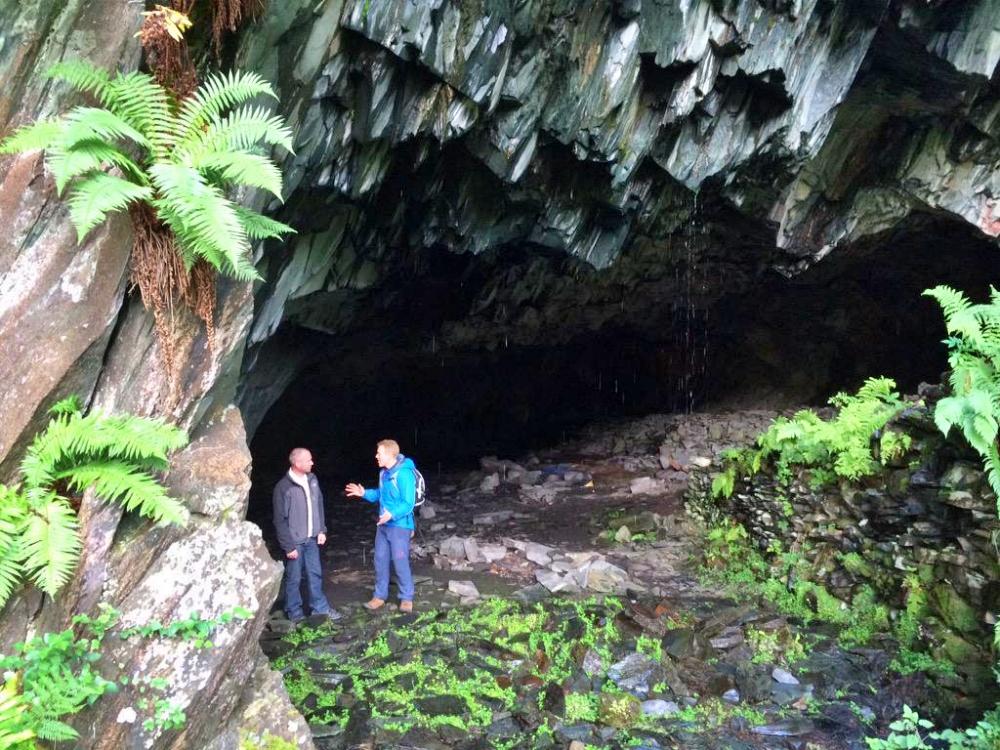
The Chief Justice of the Common Pleas
October 2014 witnessed JD Wetherspoon open its first pub in the English Lake District, despite protests from local businesses concerned about the loss of trade. The transformation of the former Keswick Police Station and Magistrate's Court, a Grade II Listed Building, into a public house aptly named by Wetherspoons as The Chief Justice of the Common Pleas, went ahead after several amendments to the design were submitted in which the court room fittings and police cells would be retained.
"And?," I hear you say. Well, several months prior to the grand opening, on 27 August 2014, I was approached by LCT Interior Solutions Ltd, an interior design company based in Chester, who supply artwork to the hotel and leisure industry. They said: "We are currently working on a project in Keswick and we would like to include some images of Millican Dalton." After supplying images to other businesses who failed to acknowledge their source, that's right, me, I declined. It seems that didn't matter to them as they simply used the images anyway. However, I must admit that their colour collage, in the room behind the Bench, does look good and is a pleasant greeting as you enter the building, but unfortunately the script contains several inaccuracies. Nonetheless, take a look if you are in town. If you want to see other photos of Millican in the local hostelries walk around the corner to the Bank Tavern where they also have a couple of photographs adorning their walls.
Farewell Miss Molly
It was with deep sadness that I learnt of Molly Lefebure’s death in Winchester on 27 February 2013 aged 93. From the earlier entries in this blog, you will have gathered that I spent some quality time in the company of Molly and her husband John. Over the years our relationship evolved from a publisher and author partnership (originating from my republication of Scratch & Co. The Great Cat Expedition) into a friendship lasting several years.
I spent many happy hours with Molly at her home at Low High Snab in the Newlands Valley, where I was always welcomed like a long-lost friend. Even though Molly was an octogenarian, she was fit and healthy and acted as the perfect host; I was well looked after and often treated to lunch in the kitchen in front of the Aga or supplied with tea and biscuits in the lounge. Molly was a strong woman with a big personality, the likes I have never met before, but on the inside she was full of kindness and happiness. Clearly well-travelled and brimming with knowledge, she maintained an air of modesty and only elaborated on her life’s achievements if asked. A quick mention of John Haigh or Harry Dobkin was followed by extraordinary stories about her time spent working as secretary for the acclaimed Home Office pathologist, Dr Keith Simpson, during World War II. Similar stories can be read in the tributes to Molly that recently adorned the mainstream press.
As a former journalist, Molly was clearly no stranger to writing and realised her exploits warranted a book. Using diaries of her time at the Department of Forensic Medicine, Molly penned Evidence for the Crown: Experiences of a pathologist’s secretary, which was published in 1955. Many of her friends considered these crimes against humanity to be too gruesome for words, but this was a successful publication and the income from her book financed the purchase of Low High Snab in 1957 for the handsome price of £500. Concerned that the woodland behind Newlands Church could be turned into a caravan park, she bought that too in order to preserve the tranquility of the area and the approach to her new home.
Ever popular, Evidence for the Crown was subsequently republished under several imprints. In 1990 the title was renamed to Murder on the Home Front. This fascinating book is a gripping read and you will quickly realise that Molly lived in a world far, far away from most people’s comfort zone. For example, as part of her work Molly saw 8000 corpses. Read it again—8000 corpses—imagine that, seeing one is enough for us sensitive souls! The synopsis for Evidence for the Crown / Murder on the Home Front reads as follows:
‘It is 1941. While the "war of chaos" rages in the skies above London, an unending fight against violence, murder and the criminal underworld continues on the streets below.
One ordinary day, in an ordinary courtroom, forensic pathologist Dr Keith Simpson asks a keen young journalist to be his secretary. Although the "horrors of secretarial work" don't appeal to Molly Lefebure, she's intrigued to know exactly what goes on behind a mortuary door.
Capable and curious, "Miss Molly" quickly becomes indispensable to Dr Simpson as he meticulously pursues the truth. Accompanying him from sombre morgues to London's most gruesome crime scenes, Molly observes and assists as he uncovers the dark secrets that all murder victims keep.
With a sharp sense of humour and a rebellious spirit, Molly tells her own remarkable true story here with warmth and wit, painting a vivid portrait of wartime London.’
You may ask yourself: Is this a story worthy of a film or television drama? You bet. As a matter of fact, you may have already watched one such drama on television unaware that it was loosely based on Molly’s memoirs. An adaptation of Murder on the Home Front was first broadcast earlier this month, on 9 May 2013, and will be released on DVD towards the end of the year.
The two-part ITV crime drama, written by David Kane and directed by Geoffrey Sax, features actors Patrick Kennedy and Tamzin Merchant as Dr Simpson and Molly Lebefure respectively.
Dr Lennox Collins (Kennedy), a Home Office pathologist new to murder cases, teams up with his secretary, Molly Cooper (Merchant), to investigate a serial killer operating at the height of the London Blitz. Witnessing the birth of modern forensic science, Dr Collins leads the chase by attempting to solve cases using new methodology, from chemical tests to controversial psyche-based methods. Together with Molly, the first female secretary to a pathologist, Lennox identifies the murderer who tries to hide his gruesome crimes amidst the devastation of the Blitz. Eventually Lennox’s unsympathetic boss, DI Freddy Wilkins, invests in his methods and theories. However, winning over Wilkins was no easy task, especially when the government was willing to convict the wrong man to ensure the nation's morale was upheld.
It’s a real pity that Molly never had the pleasure of seeing her work transformed from a book into a television drama, but nonetheless she has certainly left an impressive legacy; one which includes children's books, a biography of Coleridge, several novels, and a fellowship of the Royal Society of Literature which she received before her death.
Thanks for the great memories, Molly! You will be missed.
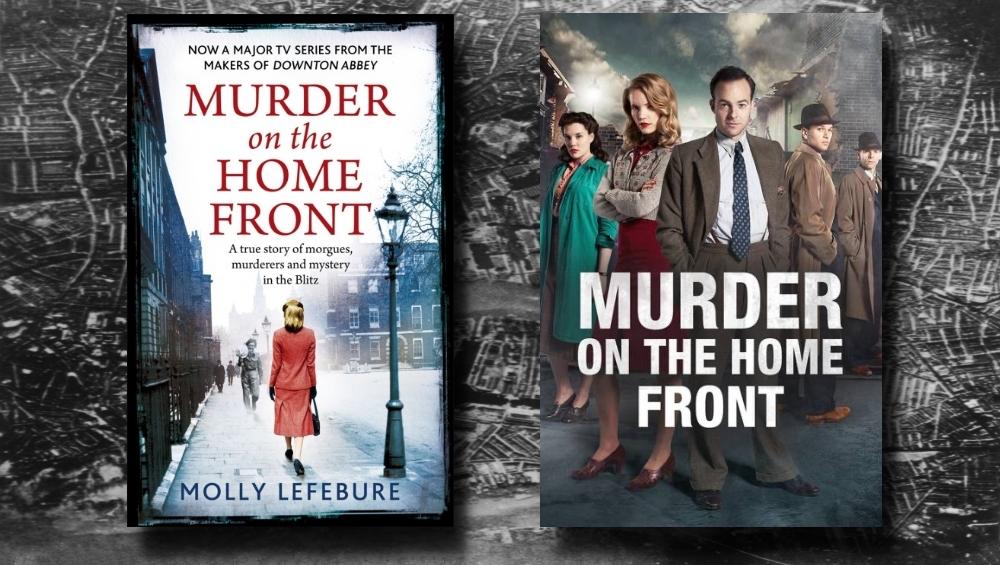
The Millican Dalton Experience
This month’s edition of the National Trust members’ magazine includes an advertisement that piqued my attention. It reads ‘The Millican Dalton Experience: Follow in the footsteps of Borrowdale’s very own “Professor of Adventure”. Experience on foot and by canoe the uncomplicated lifestyle of Millican Dalton. Adult £50, booking essential. Saturday 19 May 2012 9.30am-4pm.’ Forming part of five-day long Keswick Mountain Festival running from 16 to 20 May, the taster session adds a historical sporting twist to the eclectic line-up. Highlights of this year’s festival are set to include over 30 guided walks, the Borrowdale Trail Run, Latrigg Fell Race, triathlons and a host of high-profile speakers ranging from Sir Chris Bonnington and Cameron McNeish to Helen Skelton and Monty Halls.
My interest was stimulated for two reasons. Firstly, and of no surprise, due to the Millican Dalton connection, and secondly because Paul Weller (no, not that one) of Keswick Canoe and Bushcraft (www.keswickcanoeandbushcraft.co.uk), an old friend of mine, is organising the event. Paul is what you would term a "top bloke"; the epitome of cool, calm and collective.
Hailing from the same hometown, in our younger years Paul and I made many expeditions to the Lake District to camp, mountain bike and rock climb. Several years later Paul decided to turn his passion into paid employment, and he moved to the Lake District in 1995. I clearly remember dropping him off at his new home—a chalet in the grounds of Newlands Adventure Centre—having secured a position as an outdoor pursuits instructor; the same site where, by chance, Millican Dalton once worked for the Cooperative Holidays Association around the same time he began offering his novel camping trips to an audience only familiar with seaside holidays.
Building on his vast experience, Paul eventually established his own business specialising in canoeing and bushcraft. Knowledge and ability are a recipe for success, and the business has performed exceptionally well since its inception. Distinguished from other businesses in the thriving local industry, his wide range of activities have attracted individuals in search of their own escapades, and corporate organisations keen to improve the team spirit among their employees. Expanding the choice of available courses in his list of itineraries, Paul developed The Millican Dalton Experience; a multi-day canoe-camping and foraging adventure, on which the taster session for the Keswick Mountain Festival is based.
Tourism marketeers now promote Keswick as the Adventure Capital of England, but few realise that they have Millican Dalton to thank for introducing multi-activity adventure holidays—undeniably the first in Britain—into the region.
It is apparent that a small Lake District collective is emerging between Millilcan Ltd, Keswick Canoe and Bushcraft and myself, who are all promoting the Millican Dalton way of life. Mighty acorns from little acorns grow! Who will be next to join our movement?
ITV The Lakes Series 2 with Rory McGrath
There is a lot to be said about the value of networking and collaboration, and this was realised when I was invited to appear on The Lakes Series 2, Episode 8 with Rory McGrath—a documentary show that celebrates the people, wildlife, and natural beauty of the Lake District— and builds on the success of the first series.
My break, a first appearance on television, was kindly initiated by Jorrit and Nicky from Millican Ltd who were asked to contribute to the programme as one of several local businesses, to which they also invited me to help showcase their brand to a nationwide audience. From the get-go Millican Ltd have been proactive with marketing, taking to the road to promote their business in person and have exhibited at some of the largest events in the country. Last year was no exception and it was on their trade stand at the 2010 Cumberland Show, hosted for the first time at Carlisle Racecourse, where the filming would take place.
Consequently, on 17 July 2010, I drove to Carlisle from East Lancashire, and on my arrival was greeted by large crowds (not for me, of course) despite the traditional heavy summer rain. Heading to the stand I was greeted by Jorrit, Nicky and the small film crew. Rory McGrath was not in attendance; his role in the show was purely as narrator and his element would be added at the editing stage. For visual appeal, a great deal of effort was put into designing the trade stand; the combination of products, photo backdrops and props (rustic wooden crates, vintage maps, retro outdoor gear, and copies of Millican Dalton: A Search for Romance & Freedom) were carefully selected to create a traditional feel to reflect the classic canvas designs of the bags. With the pleasantries and introductions complete, the crew talked though the scene they wanted to create. All was straightforward and with plenty of visitors taking interest in the stand the filming was ready to roll.
As Millican’s ‘Originals’ range of bags are named after friends, I was filmed being introduced to my eponymous daypack, before we briefly chatted about the style and available colours. Closing the scene, I described my pleasure at having a rucksack named in my honour, and my surprise at the success of my book and the journey it had taken me on. Unfortunately, I didn’t have time to hang around to look around the other attractions, and I left for North Wales and the village of Y Fali (Valley) on Anglesey for a few days camping and sea fishing around Trearddur Bay and Cemaes Bay with a friend.
Broadcast on 21 January 2011, I was delighted with the editing and how show was portrayed. Receiving more airtime than expected, a shot of my book thankfully appeared during the piece and online sales rocketed into the stratosphere. It was an exceptional result for Mountainmere.
Lancashire Climbing & Caving Club Lecture
Now that the summer is all but a distant memory, the long dark nights and first frosts of the year have heralded the start of the winter lecture season that forms an essential midweek stopgap for outdoor enthusiasts until the arrival of next spring.
On the agenda this week was my long running Millican Dalton lecture for Lancashire Climbing and Caving Club who invited me to the second indoor meet of their series held at the Doffcocker public house in Bolton.
Although the lecture is now in its 7th year, a new audience discovers the story of Millican Dalton year after year, providing a continual demand. The event proved popular with around 40 members attending the evening, and the hour long illustrated lecture, comprising of a plethora of unpublished photographs, was well received.
Review: An Eponymous daypack. Verdict: Great for work & play!
Millican Ltd co-founders, Jorrit and Nicky, are celebrating the first anniversary of their Millican Dalton inspired travel luggage brand with the release of a new collection of bags and accessories for 2010. Amongst their new products is a little gem of a daypack, which is equally at home on the daily commute as in the mountains.
Continuing the theme of naming their products after friends is this new daypack, which I am proud to announce has been named after yours truly. The entrepreneurial husband and wife team, who live in Keswick, took a two year break from their high-flying careers to decide on a new, more fulfilling future. I was amazed to eventually learn that my book Millican Dalton: A Search for Romance & Freedom was the inspiration behind the couples venture, and partnered with their love of vintage luggage, and their inside-out knowledge of business decided to take the plunge and put everything on the line in order to work for themselves from home running a business that reflected their eco-friendly outlook on life.
This daypack is a high-end, expensive piece of equipment, and the £120 price tag for a 22 litre capacity bag could be out of budget for all but the keenest greenies, but then value can't be measured just in pound notes, right? Jorrit and Nicky have decided to avoid the highly competitive budget market awash with £5 rucksacks. Instead, in return for you pounds, they offer what very few other travel brands do, and that's a range of sustainably sourced, ethical products with a conscience, based on proven classic designs. This means that this daypack, as with all their other bags, is made from the companies trademark materials which give the bag a tradition look and feel. The eco-conscientious, and of course other shoppers after something quirky, will be interested to note that the bag is a combination of 100% organic canvas, which forms the body of the bag (lined in waterproof 100% recycled polyester), a waterproof 100% recycled polyester cover which unravels from beneath the sack providing wet weather protection, and 70% vegetable tanned leather.
With a front-opening zip allowing remarkably good access to the inside, it contains four pockets (including one for an iPad or laptop). The air-mesh padding on the back panel section of the bag is ample and comfortable to wear, as are the shoulder straps. The lid is held down with a series of press studs that offer a good alternative to buckles, and give the daypack an Alpine look.
Overall a great piece of kit, not solely for use in the mountains as it isn't dedicated mountaineering equipment, but if you're looking for something that little bit different, that can be used during the working week and for free-time at weekend then look no further.
Groundbreaking Mountaineering Film
We're not talking Sly Stallone's Cliffhanger here, forget that. What about Touching the Void, Set in Stone, or K2? Great entertainment? Yes. Groundbreaking? Most definitely not. In fact there's only one motion picture that can claim that revolutionary accolade, and that is Stanley Watson's High Hazard: Where Mountaineers are Made, which was, undoubtedly, responsible for kick-starting the evolution of British mountaineering film.
This month sees the 75th anniversary of High Hazard's Premier at the London Trade Show, and to mark the milestone Mountainmere are re-issuing the black and white film on DVD so that a new generation of mountain connoisseurs can savour the product of an industry in its infancy.
Though I can hardly expect many people to remember it, there was actually a time when mountaineering cinematography was solely the domain of professional moviemen. Unfortunately, their lack of knowledge and ability in the mountains severely hindered the evolution of extreme filming techniques.
Whether through a reluctance to carry their heavy apparatus or professional apathy, the cameramen never ventured too far into the mountains and had only ever caught short glimpses of the easier, more accessible climbs. There was a common problem—as non-climbers the cameramen could not climb up with the party to obtain the best viewpoints, but instead accepted second best and took their films from the tracks below. Clearly their naivety was a travesty of what a real rock climbing film should be, capturing none of the exposure or risks associated with the sport.
Failures in the industry were eventually confronted by Stanley Watson, Chief of the British Mountain Guides, who, dissatisfied with previous attempts to film mountaineering and rock climbing, was inspired to make his own film, High Hazard. Watson was one of the country's leading rock climbers, already a proficient climbing guide, keen photographer and artist. Sure he had the necessary skills, he formed his own production company, bought five cameras, nominated himself as producer and in May 1934 set about filming with a cast of friends and employees.
"I have nothing derogatory to say against the somewhat meagre attempts which have been made so far to film rock climbing," said Watson. "The best effort to-date was in the silent picture The Romance of Wasdale and the success of the climbing shots was due entirely to the vast photographic experience of the brothers Abraham of Keswick. However, High Hazard is one long thrill. We have taken movie cameras where no camera has ever been taken before."
Of course it wasn't as easy as it sounds, and as a newcomer to the film world Watson faced considerable scepticism and indifference. However, he had an ambition which rose over everything and he set out to make a picture that professional moviemen would be forced to accept. High Hazard became the first complete photographic record of British rock climbing, with film shot from those previously-elusive camera positions. Carrying several cameras for miles bodily over the rough mountain tracks, and hauling them by ropes up perpendicular precipices hundreds of feet high, Stanley Watson and his British Mountain Guides secured pictures of world famous cragsmen at work. Highlights of the film include Vivian Verity, the nine-year-old "baby rock climber," scaling Napes Needle, J. E. B. Wright and Co. making the second ascent of Trophet Arête and Watson demonstrating how to climb Kern Knotts Crack...blindfolded.
Watson had foresight and ambition—and in that post-Depression era he knew that he had to have if his film was to be a success. With this sort of outlook tempered with his climbing ability and the artistic creativity to carry it all off, Watson offered his audiences a view of what adventure in the mountains really looked like, and, more importantly, what mountaineering film could become. Undoubtably the groundbreaking filming techniques used by Stanley Watson set the precedent for which all subsequent mountaineering films had to follow. A classic amongst classics? You decide!
High Hazard, presumed lost for the majority of the 20th century, was first brought to my attention in November 2003 when I was approached at one of my Millican Dalton lectures by Barney Whiteside from Kendal. As I found out, his mother had nursed Watson during his final years, and on his death had acquired one of his photo albums, which had been earmarked for the bin. Additional to details of his other achievements, the album contained a myriad of newspaper clippings and photographs chronicling the production and release of the film. Barney, very kindly, gave me another clipping to keep. It was an article from a 1941 edition of The Whitehaven News detailing Millican's occupancy of the "Cave Hotel."
Using this album, and further material of Watson's held by the Mountain Heritage Trust (whose archivist, Maxine Willet, had previously attempted to locate the film without success) (www.mountain-heritage.org), along with several of months of searching, and, importantly, a touch of good fortune, I managed to locate a 16mm celluloid copy of the film in a private collection. As they say, the rest is history.
High Hazard: Where Mountaineers are Made
Stanley Watson et al
- DVD-Video (PAL format)
- Black & white with mono sound
- Duration: Approx. 16 minutes
- Classification 'U'
- RRP: £5.00 + free P&P
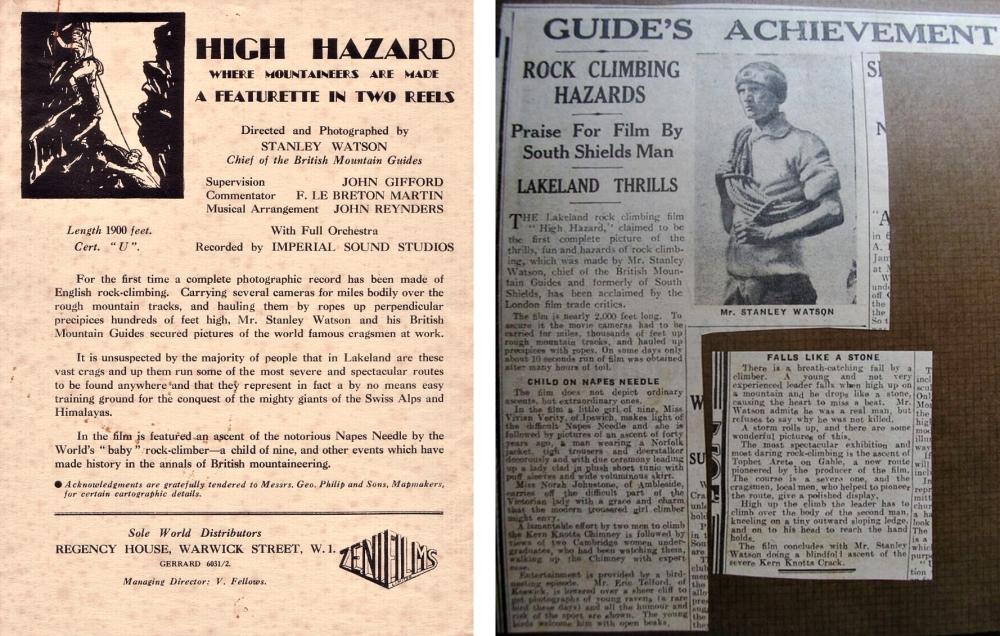
Millican's Cave Re-opens
The National Trust have now re-opened Millican's cave after an extensive and expensive survey. Their sterling efforts required every single piece of stone to be removed from the floor of the cave, and to be placed in a pile away from the area of the rockfall. Anyone who knows the cave will recognise that this must have been a huge undertaking. The cave was then monitored for further falls, but following another geological inspection the green light was given and the cavern re-opened.
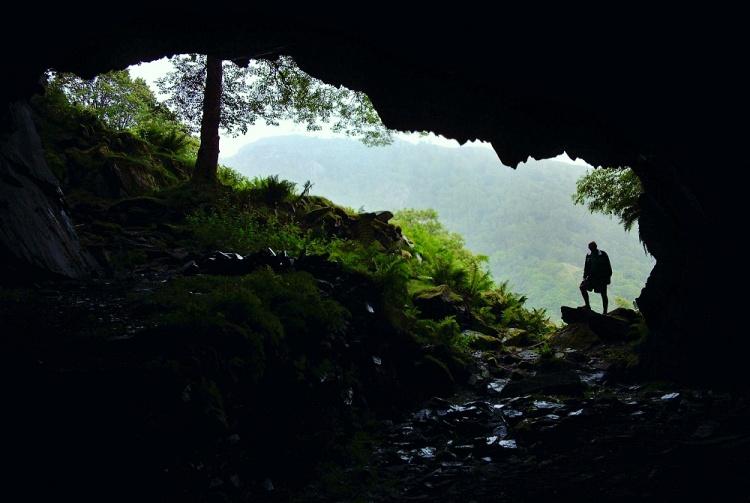
Rockfall at Millican Dalton's Cave
Modern-day nomads seeking shelter in Millican Dalton's cave will have to look for alternative accommodation this Spring after the Borrowdale bivouac spot was closed because of a recent rock fall in the lower chamber. Amid safety concerns that further rock falls may occur, the National Trust have taken the precaution until a full structural survey of the cave has been carried out.
Countryside officer Penny Webb said "One of our wardens discovered the rock fall last week. It's not a particularly big one, perhaps the size of a large TV set, but we are advising people not to go into the cave. We have asked some specialist geological assessors to look into it."
The cave will remain closed until further notice. So, campers, unfortunately you'll have to search elsewhere—beneath the Bowder Stone and the "Secret Cave" can both be recommended—but don't forget that indiscriminate camping in England is illegal except for Dartmoor. What, you want to learn more about the "Secret Cave?"...okay, fair enough...continue reading.
LAKELAND'S WORST KEPT SECRET:
Imagine a refuge in the hills—half naturally formed, half man-made—with a fireplace and chimney, double bed and bunks, piped gas, shelving, visitors book, rear store room and emergency exit; all carefully draft-proofed and insulated, and protected from the extremes of the Cumbrian weather by a substantial, stone clad, steel framed door, which opens...wait for it...remotely by a quick tug on a hidden cable. Something from The Famous Five? No, real life!
As far as secrets go Lakeland's so-called "Secret Cave" would have to be the worst kept. Of course it's hard maintaining the obligatory oath of secrecy especially when we discover something out of the ordinary, and in this instance the urge to tell others has had a detrimental effect on one man's remote, high level, painstakingly crafted bolthole. That said, if it wasn't for human natures imperfections I wouldn't have learnt of the cave, and I'm therefore indebted to the Keswickian lass who, as far as I'm led to believe, was responsible for bringing the cave to the attention of a wider audience after a local outdoor pursuits instructor had taken her there for a night of passion. Until that point annual visitors to the cave were numbered in single figures, but after the cave was "Christened" visitor numbers, as recorded in the visitor book, rocketed.
Those of you who know the cave will be quick to point out that it's not actually a true cave at all, but a cavity under a mass of huge boulders. This proved the perfect basis for conversion, and the architect, incorrectly rumoured to be a ship builder from Barrow-in-Furness, spent week after week hand balling the necessary wood, steel, sand and cement, and other building materials and tools up into the hills; which in itself is commendable.
I first visited the cave in the late 1990s when it was still in its prime, whilst everything was fully functional and intact. The initial search for the cable to release the door catch was memorable, and I clearly remember watching in amazement as the door swung open beckoning us to enter. We spent a comfortable and enjoyable night there, and spent a few further nights there over the next couple of years.
On returning over a decade later, I was disappointed, although not at all surprised, to find the cave in a somewhat weary state, and a shadow of its former glory. Long gone was the stone in the door, along with its clever opening mechanism. Although the angle-iron doorframe remained it was wedged shut and entry had to be made by climbing through the remaining aperture. The erstwhile cosy and well arranged interior was littered with dumped bedding and rubbish. The cave is now on the tourist route and the many explorers who make the journey there can now follow the easily visible track right to the threshold.
2007 Lakeland Book of the Year Awards
Last year’s republication of Scratch & Co: The Great Cat Expedition brought with it the opportunity to enter the Lakeland Book of the Year Awards once more. With four review copies already submitted and two tickets purchased for the charity luncheon, I had arranged with Molly Lefebure to attend this year’s awards which were held at the Grade II listed Langdale Chase Hotel on Tuesday 26 June 2007.
Collecting Molly from her home in the Newlands Valley, we made the scenic drive down to Ambleside and onward to the hotel. On arrival, Molly’s appearance in the wood panelled entrance hall of the Langdale Chase Hotel roused considerable interest and her status among the literary community became obvious when she was instantly greeted by members of the Wordsworth Trust. The reaction of excited onlookers was priceless. This should have been of no surprise because, of course, Molly is a well-known author and former winner of the 1988 Lakeland Book of the Year Awards with The Bondage of Love: A Life of Mrs Samuel Taylor Coleridge. By the look on her face I could tell she was in her element and clearly happy to chat to friends and acquaintances. The best thing? I made it happen. It was a privilege to escort Molly, and I was proud to be there in the capacity as her publisher.
I know the Langdale Chase Hotel well, having previously worked there for several months as a night porter. It was an easy job where I had the (unofficial) opportunity to spend time in the early hours reading, writing and eating ham sandwiches between patrolling the corridors and setting up the dining room for breakfast. The hours didn’t suit and as with most positions in hospitality poorly paid, so I didn’t last long.
Anyway, back in the room I chatted with Jan Levi whom I had assisted with information regarding Millican Dalton for her book entry And Nobody Woke up Dead; the biography of Mabel M. Barker, the greatest female rock climber of her time. As is the norm, the event was very well attended and the hall abuzz with talk of literature and publishing. It was evident everyone had made an effort judging by the number of suits and cocktail dresses.
With fizz and canapés consumed our master of ceremonies signalled the start of the charity luncheon and ushered us into the dining room, which affords tremendous views over Windermere, Claife Heights, Wray Castle, the Langdale Pikes and the fells beyond; though to be honest the scenery was something of a distraction. I had seen the shortlist several weeks ago and was aware that Scratch & Co: The Great Cat Expedition didn’t feature, but the event was a good networking opportunity. It’s in the social calendar for Lakeland writers and publishers.
Hunter Davies and his judging panel delivered their verdicts with Beatrix Potter: A Life in Nature by Linda Lear crowned the overall winner.
Leaving Low Wood Bay behind we drove back to Newlands in high spirits. Molly is an amazing woman; she is dignified and cultured. I have learned a great deal from my time spent with her. Whilst we won no prizes, we have plenty to celebrate as we thoroughly enjoyed our day out together.
Lefebure & Wainwright on BBC4
To mark the centenary of A. Wainwright's birth, the highbrow television channel BBC4 showed their recently completed documentary Wainwright: The man who loved the Lakes. My friend, the delightful Molly Lefebure, took part in the filming from her home in the Lake District, and gave viewers an insight into her close friendship with Mr Wainwright.
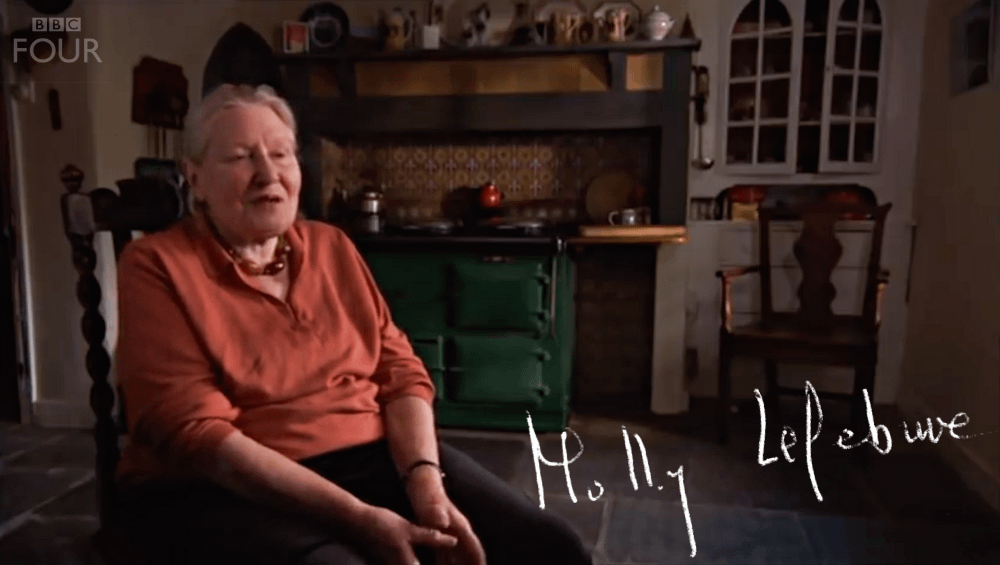
Friends of Keswick Museum Lecture
M. D. Entwistle delivered his ongoing Millican Dalton lecture to the Friends of Keswick Museum at Crosthwaite Parish Room, Keswick, Cumbria, on 7 February 2007 at 7.30pm. For the locals in attendance, including Alan Hankinson, it was their first time watching Millican Dalton on the big screen, and the archive footage from January 1941 certainly raised eyebrows.
England's Highest Book Launch
Have you ever been to a book launch? Personally I never fancied the long queues, overcrowded stuffy rooms, tardy authors, and the whole black tie affair; until, that is, I decided to republish Molly Lefebure's Scratch & Co. The Great Cat Expedition to celebrate Alfred Wainwright's Centenary. A more appropriate launch was in order though, you know, something a little different and more in keeping with my passion for the outdoors. Cue Scafell Pike.
No doubt considered as the most unlikely location for a book launch, the roof of England was, for this occasion, the perfect choice for this classic, Wainwright illustrated, mountaineering novel. Scafell Pike (3210ft / 978m), better known in Scratch & Co. as the Highest Known Peak (H.K.P.) and the centre piece of the story, has been host to many strange ceremonies over the years. This event added to the mountain's list of credentials, and was a complete contrast to those booklovers used to predictable, bookshop based launches. This quickly become apparent as the walk from the car to the event was several miles further than usual, but the fact that complimentary red and white wine and a gourmet cheeseboard were on offer was a good enough reason for anyone to join in.
On the morning of September 9, 2006, after spending the previous night at Edmondson's farm campsite at Seathwaite, the Mountainmere team set off for the summit venue loaded to the hilt with books, food and beverages—not forgetting the display table.
As expected the dog days were none existent, but a fortunate break in the persistent inclement weather that plagued the end of summer—the first dry, sunny day for weeks—ensured that the launch could be enjoyed by the scores of hikers who arrived on the top of Scafell Pike, and who inadvertently joined in the launch party jovialities.
Between 1pm and 3pm rumours of cheese and wine spread over the summit plateau, which were instantly dismissed by some hungry and thirsty walkers as cruel jokes, who were left flabbergasted when they arrived wearily at the summit cairn to be greeted by the equivalent of an oasis in the desert. Their facial expressions and comments were priceless. This was no mirage though and the occasion took its place in history as Britain's highest book launch to date.
Available now from all good booksellers:
Scratch & Co. The Great Cat Expedition
- New Edition
- 160 pages
- 14 black and white line drawings
- Case bound laminated hardback
- ISBN13: 978-0-9547213-1-2
- Printed in Kendal, England
- RRP: £11.99
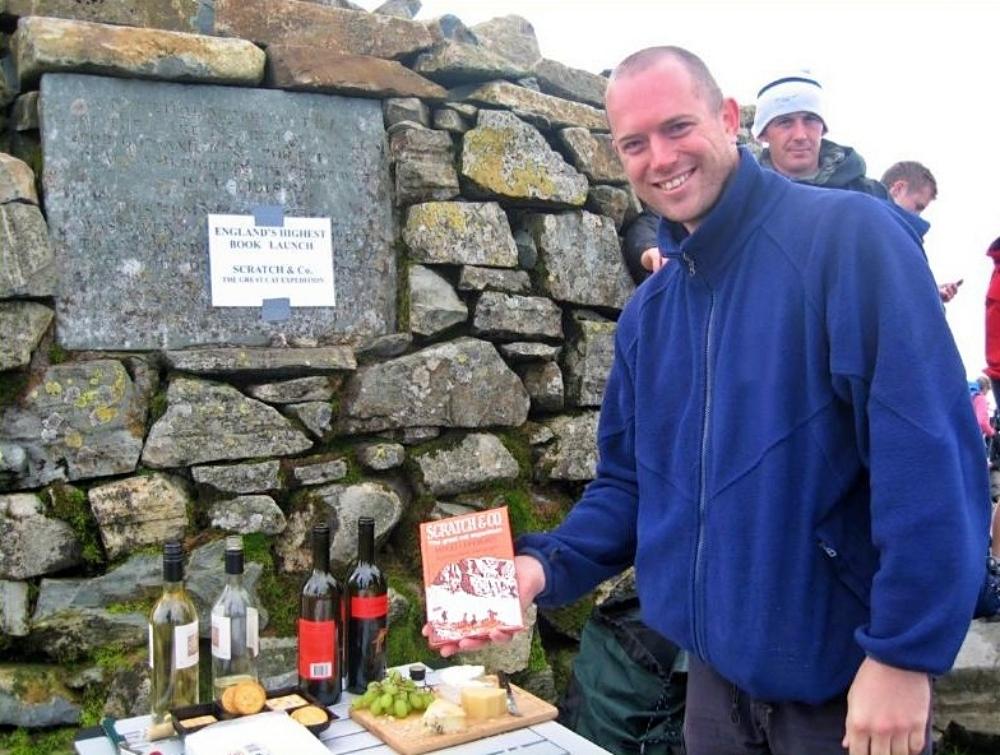
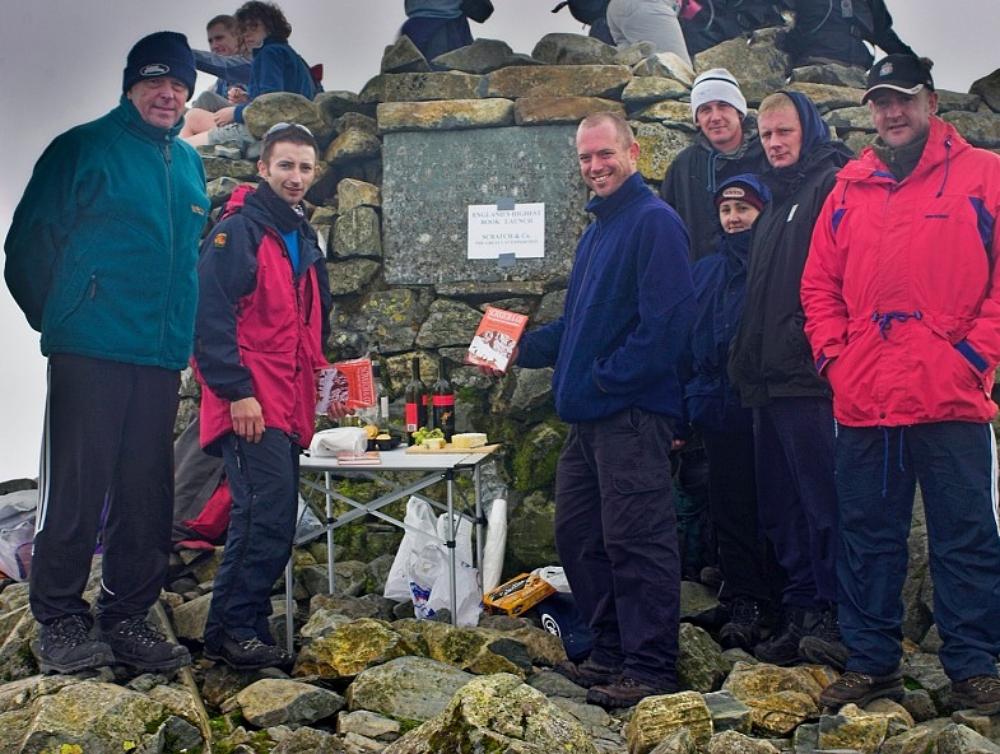
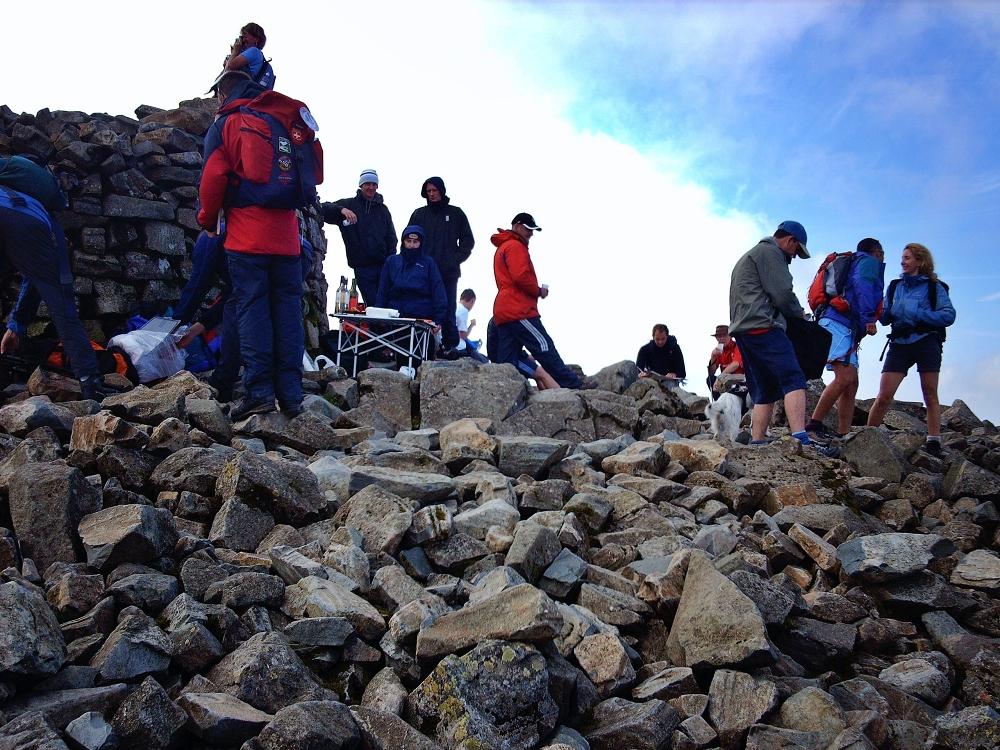
BBC Radio Cumbria: Scratch & Co.
Although initially starting out as a complete novice in the publishing industry, I would like to think that, despite the steep learning curve, my marketing skills have developed rapidly. Admittedly, they are nowhere near the levels achieved at Saatchi & Saatchi, but, considering the media’s positive reception of my books and their willingness to feature them in their productions, I am more than happy with the results to date.
Continuing with my book promotions, I recently sent BBC Radio Cumbria a press release informing them of the pending republication of Scratch & Co: The Great Cat Expedition and they responded by inviting Molly and myself for an interview. This, in part, was facilitated by the fact that Molly is well respected in literature circles and a well-known figure in Cumbria.
Yesterday, Friday 1 September 2006, I collected Molly as usual from her home (you may have gathered from previous posts that she doesn’t drive) and we made the journey from Newlands to the BBC Radio Cumbria studios on Annetwell Street, Carlisle. Once there, we were warmly welcomed, and I Joined Molly in the studio for our joint interview with Gordon Swindlehurst. We followed hot on the heels of Sir Chris Bonnington, who had attended an interview on the Breakfast Show; it was 40 years since the first British ascent of the Eiger North Face Direct. Chris, the greatest living British mountaineer, had played a supporting role to Ian Clough on that formidable climb…but as our host, Gordon, said, “That pails into insignificance with Scratch & Co. The Great Cat Expedition.” What a great introduction!
Sat beneath the ‘On-Air’ light, Molly gave her synopsis of Scratch & Co., and then went on to discuss her friendship with Alfred Wainwright and why he was selected to illustrate the book. By simply passing him a manuscript without any demands, she made it clear that, as they shared a good working partnership and understood each others work, she trusted his judgement. There was an insight into Molly’s methodology, too, and she explained how the book’s characters were defined before the storyline was outlined. Elaborating on this, she explained how one of the book's characters was based on Ernest Hemingway and another on an undisclosed journalist and ex-colleague at the News of the World. Scratch & Co. was a success from the start, and Molly rejoiced in the fact that Alpine Club members “bought copies like hot cakes.” Shocked that Scratch & Co. had become a cult book, she said that she was thrilled at having it republished. Molly is a seasoned professional and spoke beautifully in her cultured voice. She talks with authority, which considering her life experience is understandable.
I then took to the microphone talking about why I chose to republish the book, my dealings with the Wainwright estate, and my reasons for making minor changes to the text. I concluded the interview with particulars regarding the England's highest book launch.
You can listen to the interview on my Media page and on my YouTube channel.
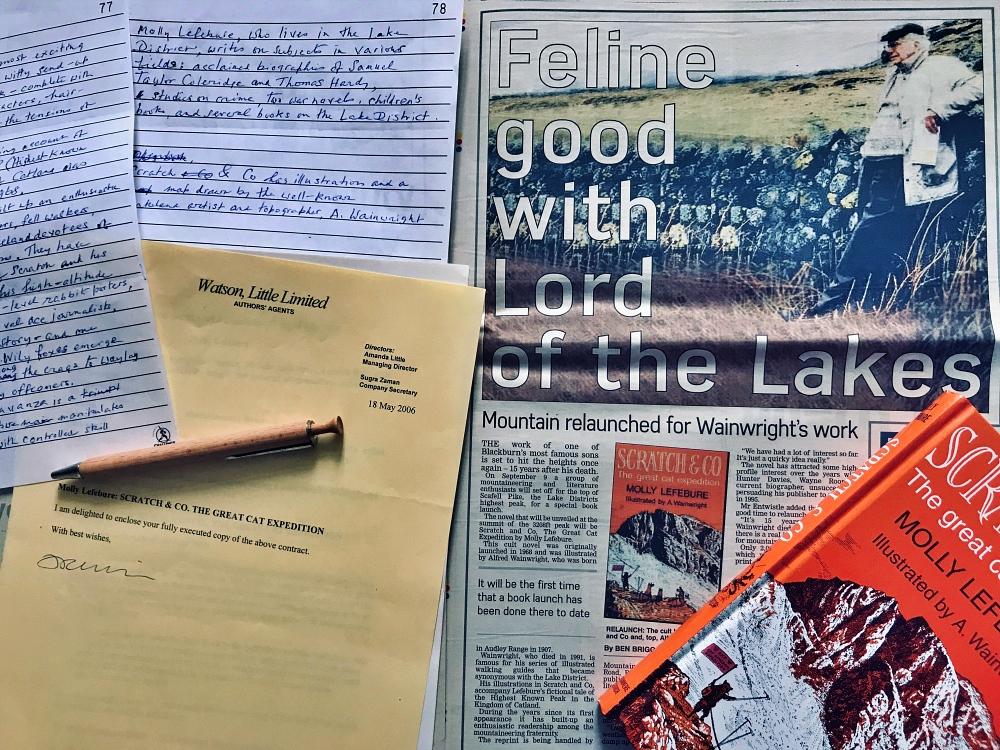
Coniston Water Festival
Earlier in the year I was invited by Grizedale Arts to deliver a talk on Millican Dalton as part of their weeklong Coniston Water Festival. Its purpose was to revive a 19th century boat-dressing pageant that was abandoned in 1998 due to lack of participation, and with several household names on the programme, including Hugh Fearnley-Whittingstall, the festival was to be given a new lease of life. Although excited about the prospect of being involved, the death of my grandad meant that I had to drop out. I was obviously disappointed, but as you can imagine, I had greater things on my mind. However, I was happy to learn that Ken Russell, of all people, stepped in for me. Now that’s what you call a substitute!
Film buffs will need no introduction, but for those who do not know, Ken is a flamboyant and controversial character; an Oscar-nominee for Women in Love and a three times BAFTA award-winning film director, whose other creations include Tommy and Altered States. Having previously lived and worked at Coombe Cottage at the foot of Shepherd’s Crag in Borrowdale, Ken was a frequent visitor to Dalton’s cave where he went to commune with his spirit, and identify with the great man’s main ideals—romance, freedom, escapism, simplicity, and truth. “I’m not sure what he meant by romance though,” Ken said, “I don’t think it was sexual.”
Commencing the days proceedings, crowds gathered to witness Olivia Plender and Ken Russell lead a band of ‘merry campers’ in felt jerkins march through Coniston village before listening to a lecture by Harry White on the Kibbo Kift, a woodcraft organisation with dreams rebuilding society and world peace. Following this Ken took my place on the stage where he praised Millican with a simple, humorous delivery.
Although I was missing from the lineup, Sally O’Reilly, who attended the event, wrote for Frieze: ‘Following White’s illustrated lecture the film director Ken Russel gave a short talk about Millican Dalton, a local eccentric who held similar notions about activity and the landscape. Dalton was an exponent romance, simplicity, and the open air, offering holidays comprising ‘camping, tramping and hairbreadth escapes,’ although his legacy is more that of a colourful oddity, a fact reflected in Russell’s own ramshackle and ironic delivery. As Dalton had claimed to invent shorts, the audience were asked to participate in a lovely legs competition, which Russell himself won, by awarding the prize to himself. The afternoon wound up with a tug-of-war.”
Whilst on the topic of Ken Russell, I may as well recollect another tale. According to Terry Gifford (Director of the International Festival of Mountaineering Literature), he had bumped into Alan Hankinson, the respected historian of Lakeland climbing, at an exhibition in Cockermouth. Alan had said to Terry “Did you know that Ken Russell wanted to make a film about him (Millican) with Spike Milligan in the part? He’s my favourite local character.”
I too had met Alan back in 2003 when I had asked ‘Hank,’ as he was known locally, to read though my manuscript of Millican Dalton: A Search for Romance & Freedom. Visiting him at his home on Skiddaw Street, Keswick, with Gifford’s comments in mind, I asked him to elaborate on the discussion of a film. Hank responded “I mentioned to Ken Russell that he should make a film about Millican. Ken said that if I wrote the script, he would make the film. However, I never got around to writing it, and that was the end of that.” If ever there was a missed opportunity, this was it!
2005 Lakeland Book of the Year Awards
To capitalise further on the successes of Millican Dalton: A Search for Romance of Freedom and keen to be involved in all aspects of publishing, last year I entered my title into the Boardman Tasker Award for Mountain Literature and the Banff Mountain Book Competition Award. We hear so much about these awards that I thought it would be a failure on my part if I did not compete. Of course, the competition attracts authors and their high calibre literature from around the globe, and achieving an award would be a difficult proposition. Nonetheless, for the book to be in the list of entries would, as a minimum, achieve part of the legacy I was hoping to achieve.
Books submitted, entries closed, shortlist created, and awards ceremonies undertaken. No, I didn’t win any awards, but we can’t let a little disappointment set us back, can we? Onwards and upwards, in January I once more submitted copies of my book for another competition—the long running Lakeland Book of the Year Awards—in order to pitch my work against other Cumbrian themed literature. Founded by writer Hunter Davies in 1984 and administered by Cumbria Tourism, the Lakeland Book of the Year Awards is a scheme which celebrates the Lake District’s literary heritage. Prizes are awarded annually for books “set in or featuring Cumbria in some way.”
Data doesn’t lie and considering my book had been the bestseller at Bookends in Keswick for months on end, with thousands of copies sold throughout Cumbria, I had real hopes of winning, or at least securing a prize in the relevant category. Though let’s be real; yes, it would be a pleasurable experience to participate, but on this occasion, I had no intention of just going along for the ride.
This year’s Lakeland Book of the Year Awards was held at the Victorian Gothic, Lodore Falls Hotel, Borrowdale on Tuesday 21 June 2005 and I had two tickets; one for my dad who is always keen to be involved, and one, as you will have guessed, for myself.
We purposely camped out à la Millican Dalton at Hollows Farm Campsite the night before the event and the next morning made our way to High Lodore. Winging it somewhat, we changed out of our camping gear and into suitable attire on the hotel’s car park, managing to dodge the glances of other guests and maintain our modesty. Slightly dishevelled, we were greeted at reception with a glass of fizz and made our way into the lounge. At first glance I didn’t recognise anyone, but after a couple of double takes spotted several familiar household names.
I must admit that I’m not the most sociable person and feeling slightly out of place (and more at home in the mountains), we happily stood away from the crowd. We had company though when linescape artist and guidebook author, Mark Richards, came over and introduced himself. We talked for a while about our book entries and Mark openly told us that his father had died the day before; you would have never guessed. I would have had to cancel, so well-done Mark for being strong and upbeat. That, my friends, is professionalism!
Seeing Hunter Davies at the opposite side of the lounge, I went over for a brief chat about Alfred Wainwright and asked him to sign a copy Wainwright: The Biography for my dad (which I had in a Co-op carrier bag; very classy). Hunter, if you have never met him, is a very pleasant, genteel man. He opened the book at the title page and said “Very good. It’s a first edition.” Aware that others were waiting to chat, I headed to the bar for a refill.
Following the drinks, we took a seat at our table ready for the charity luncheon. “What are you here for?” was the first question I was asked. “I’m behind the Millican Dalton biography,” I proudly responded. That was enough of an introduction to prompt Bill Birkett, who was sat opposite, to tell me that he had a copy of my book on his bedside table. Yes, I was glowing inside! Next to Bill was David Rigg of Titus Wilson, the very chap who prints my books.
We dined on blue swimmer crab and avocado timbale for starters; roast sirloin of Lakeland beef with fondant potato, stuffed vine tomato and a morel and brandy cream sauce for mains; and finished with a Lodore couverture dessert platter. It was as tasty as it sounds.
Fed and watered, the awards ceremony commenced. I was rather tense at this stage and when Fiona Bruce passed comment on my book as one the judges enjoyed reading, I was ready to take to the stage to collect my prize. Easy excitable you may ask? Yes…and I was soon left deflated when the category winners were announced. Taking the overall prize was The Lake Artists Society: 1904-2004 – A Centenary Celebration by Jane Renouf. I offered my congratulations to all winning authors and publishers.
We left and made our journey home. Although somewhat disappointed we enjoyed the wonderful experience.
The Lakeland Book of the Year Awards is a well organised event, and as you can imagine each segment managed to perfection; it runs like clockwork. It is evident that the awards benefit from 20 years prior experience.
Keswick Museum Exhibits
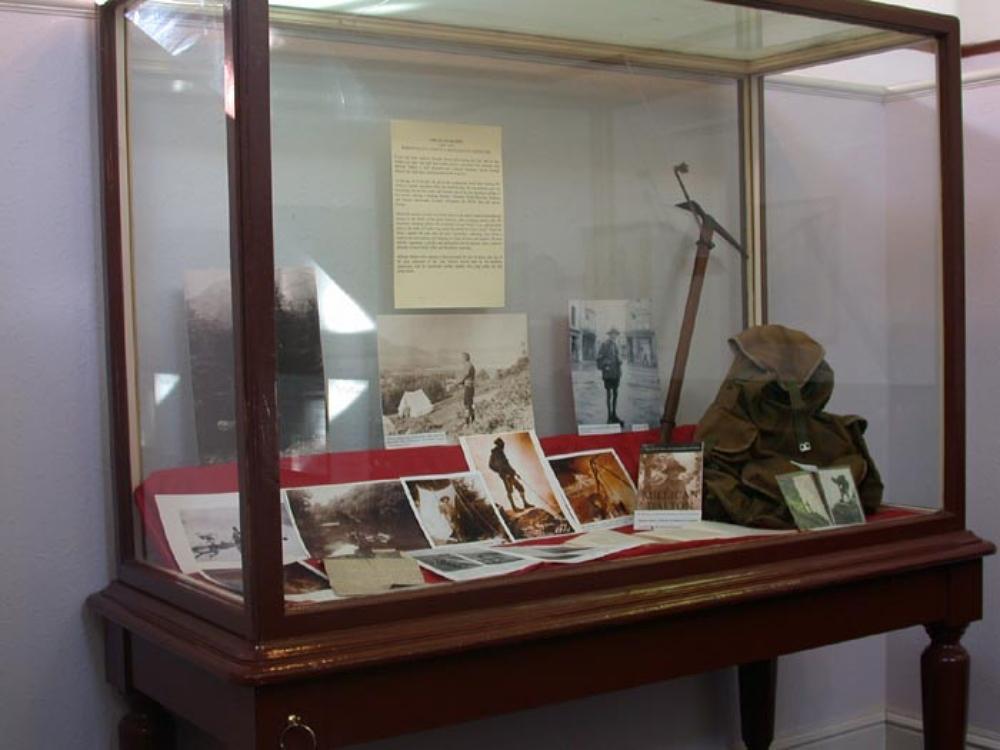

Kendal Mountain Festival 2005
Kendal Mountain Film Festival has expanded in recent years, and this year was no exception seeing the introduction of the Kendal Mountain Book Festival. The theme of the 2005 combined Kendal Mountain Film and Book Festival (www.kendalmountainfestival.com) was "Wild is a place of the heart." Unsurprisingly, the nine-day festival featured talks and presentations by renowned figures from the world of mountaineering. Julie Tait, director of the Kendal Book Festival, said: "We've brought together people who have devoted a good deal of thought to wild places. Panelists will present their perspectives on and personal experiences of wild places, and discuss those writers and cultural figures who have captured, preserved and promoted its special qualities."
I was lucky to feature amongst the events. The session was promoted as ‘M. D. Entwistle in conversation with Terry Gifford' and we talked about my book Millican Dalton: A Search for Romance and Freedom which, as you may know, tells the fascinating tale of the self-styled Professor of Adventure who lived in a cave in Borrowdale. It was good to meet up with Terry again after seeing him last at the International Festival of Mountaineering Literature. As a man moving in the right circles, he had arranged for me to attend Kendal. If you need a step up, do everything you can make good contacts!
My lecture was held on 17 November 2005 in the Local Studies Department at Kendal Library. Although not quite as impressive as taking to the stage at the Brewery Arts Centre, I still had my own platform. The two hour questions and answers session took the form of an informal conversation. Accompanied by rare archive photographs, the audience were encouraged to appreciate the important contribution Dalton made to climbing and to the philosophy of adventure. With tickets pitched at an affordable price of £3 each, there were plenty in attendance. Considering that other events were taking place in town, which can lure people elsewhere, the number of bottoms on seats showed that there is plenty of interest in Millican Dalton.
Book sales and signings followed the presentation. For someone to voluntarily purchase your book and ask you to sign it is such a reward, one which money cannot buy, and for me it’s better than the financial gain. Having my work promoted alongside some of the biggest names in mountaineering is a recognition of the highest order. As with earlier experiences, the contrast between working in a Windermere service station one day, then lecturing and signing books the next was huge! With hand on heart, I can honestly say that with the experience gained from previous lectures in my armoury, I was relaxed and found the whole experience a joy. I have no issue in disclosing that the fee for a speaker at my level was £100. I have invested this in Mountainmere and put the money towards a larger print run.
Overall, it has been a very successful year for myself and my book, and have gained a valuable skill set which will help Mountainmere move forward. That warrants a big thank you to Terry Gifford and the team at Kendal Mountain Festival for their fantastic support.
The timing of the Kendal Mountain Festival was perfect. I have just quit my job and leave England for a three month trip to the east coast of Australia at the end of this month.
18th International Festival of Mountaineering Literature
The publicity machine has finally produced an incredible result; one that I could never have predicted! Following the release of Millican Dalton: A Search for Romance & Freedom in March 2004, I was approached by Terry Gifford. We had history; I had previously written to Terry regarding his book in The Joy of Climbing in which he referred to being in the company of Millican during his climb of Pencoed Pillar. Querying how they could have possibly met considering the dates didn’t tally, Terry made it clear that he was writing about Millican’s spirit or ghost. Query closed, I finalised my research and proceeded to the publication stage.
Fast forward a few months, and Terry was in contact once more; this time requesting a review copy. Duly sent, it must have gone down well, as I was then invited to participate at the 18th International Festival of Mountaineering Literature as a guest speaker. The theme of this years event was "Whose History?" which asked the question: Who is actually responsible for preserving mountaineering history? In keeping with this theme, Terry proposed that my keynote lecture would be titled “Neglected Climber.” Festival goers would be treated to introductions by Greg Child and Chris Jones; and various lectures, in chronological order, from Robert Marshall, Kaydee Summers, myself, Jim Perrin, Robert Sale, Steve Dean and Ian Smith.
If you don’t know, the mission of the festival is to celebrate, promote and develop mountaineering writing by providing a high profile, dedicated one-day festival which encompasses the showcasing of new books, commissioning of new work and critical debates. My book promotion was really beginning to gain momentum; indeed, this was a significant moment, and it was full steam ahead.
With two tickets in hand, my dad and I set off for the festival and made our way over the Pennines to Leeds on a dark, snowy Saturday morning, causing some concern whether I would arrive in time. Not to worry, we reached the Bretton Hall Campus at the University of Leeds with time to spare, and met Terry who was welcoming guests and speakers in the entrance atrium. Intense chatter and beaming smiles were the order of the day. Cliques were clearly identifiable. Why wouldn’t there be? Most speakers in attendance knew each other previously, but it seemed awkward trying to step into their inner circle. Undeterred, I made my introduction before making my way into the lecture theatre and taking my seat on the front row.
Attracting an audience of 200 delegates from the world of mountaineering, including Sir Chris Bonnington, Jim Curren and a host journalists from the outdoor press, heralded a daunting prospect. To say I was nervous would be an understatement, but I was very well prepared. Working at Windermere Service Station in the heart of the village, I had used the quiet periods to rehearse my 20-minute lecture, subsequently reaching the point where I could recite it perfectly without notes. There is much truth in that old adage: practice makes perfect.
The festival commenced on time, and although the preceding speakers took to the podium, I paid little attention (sorry folks!), and used the time for one last rehearsal. Kaydee Summers finished her presentation…it was my turn! I took to the stage, and after a deep breath delivered my lecture (the full lecture will be printed in the Climbers’ Club Journal 2005). The theatre was dimmed, and I was left alone under the spotlight, both physically and metaphorically. In all truth I couldn’t really make out any faces in the audience and as you can imagine this made the situation much easier enabling me to recite my lecture without fault.
Questions and answers followed including some irate, bigoted comments from journalist and author Colin Wells who challenged my theories; though I was quickly defended by another delegate who responded, “don’t attack the speaker!” Result! Audience members triggered and discussion stimulated! There on merit and confident that my points were valid, I responded with reasoned facts. There was no harm done, no damaged pride and no sleep lost. After all, who cares? I was happy that the critique was part and parcel of putting yourself on a pedestal to promote your work.
Proving a point for comment, my unaided delivery impressed Festival Director Terry Gifford who queried my lack of notes. I took this as a compliment, and it turned out I was the only lecturer to work without reference material or visuals, managing to maintain eye contact with my audience throughout the lecture. My point? Who wants to pay to sit in an audience and look at the top of someone’s head?
We broke for lunch served in the university refectory, and I was periodically interrupted by delegates who ask me to sign their copies of Millican Dalton: A Search for Romance & Freedom. This was a joyous moment and i thoroughly enjoyed being approached by people who had voluntarily purchased by book, wanted a quick chat, and requested a personalised note in their copy.
It was an advantage to be positioned at the beginning of the agenda, and with my job done, I sat back and listened to the efforts of the remaining speakers. The festival ended and everyone said their goodbyes before leaving in opposite directions. We had been invited to Jim Curran's home for the end of festival wrap party, and then to bunk at the house of Terry's friend, but I changed my mind last minute and went home to celebrate with my family instead. It was possibly a missed opportunity to make more contacts, but I was happy with my decision at the time.
The contrast between working in a service station one day and lecturing to 200 people the next made the whole day a euphoric experience; one I will always remember. For my efforts I received £25 for expenses and a cut of the book sales, and whilst this may not seem much the real reward was the publicity I gained and the associated promotion of my book.
I have nothing but praise for Terry Gifford, who has taken me under his wing, and who unconditionally offered support and indispensable advice. Terry is most certainly one of the good guys.
Windermere Author puts the 'Record Straight'
A Windermere author has been invited to an international festival to put the record straight about the eccentric Lake District character Millican Dalton.
Writer M. D. Entwistle will give one of the keynote lectures at the International Festival of Mountaineering Literature at Leeds University next month. He will focus on the life of the legendary mountaineering guide, who worked in the Lake District in the early part of the 20th century.
Dalton, known as the Professor of Adventure and Caveman of Borrowdale, remains part of mountaineering folklore and his name still raises eyebrows long after his death.
Mr Entwistle, author of Millican Dalton: A Search for Romance and Freedom, said: "Dalton's reputation for eccentricity tended to overshadow his climbing record. I make the claim for his climbing and his philosophy to be taken more seriously."
BBC Video Nation
In 1937 a social research group under the potentially worrying name of Mass Observation was established. Their aim was a social study; one in which a team of observers and a panel of volunteer writers would study the day-to-day lives of ordinary British citizens to create an "anthropology of ourselves."
These studies produced wide focused and highly detailed results. Observers were tasked with recording behaviours in various public settings such as consultation meetings, spiritual gatherings, sporting, and leisure activities both in the workplace and in the street. The panel of volunteer writers, sourced from different demographics across Britain, maintained journals or replied to Mass Observation’s open-ended questionnaires. Mass Observation studies continued throughout World War II and into the 1950s, with the results published in reports and as a series of books.
As miniaturised video cameras with simplified operation become available during the 1980s and 1990s, a new, popular format developed in the form of Video Diaries. In 1993 the BBC’s Community Programmes Unit took advantage of this phenomenon, and Video Nation was born. Using film equipment dotted across the UK, the contributors were given free access to a Hi-8 video camera and asked to record their daily life for a year. The media reacted instantly to Video Nation:
The Guardian wrote ‘The immediacy of these programmes is entirely different to anything shot by a crew. There seems to be nothing between you, not even the glass…’ Polly Toynbee, journalist and writer, regarded it as ‘a television gem of immense value.’
There was no shortage of volunteer filmmakers, and more than 10,000 videos were created and posted to the BBC. Approximately 1300 shorts were selected, edited, and televised, with viewing figures ranging between one to nine million. In the early 1990s Video Nation ported to BBC2 ensuring the continuation of the early sociological photographic projects.
At the beginning of the new millennium, Video Nation continued to operate from 33 regional centres, working in partnership with a network of local producers throughout the UK who were dedicated to creating videos on a wide range of thought-provoking subjects. These videos could be considered the precursor of modern-day online vlogging.
That’s all well and good, but what’s this got to do with me, I hear you say? Well, although a little late to the party, I became aware of the opportunity to participate whilst reading the BBC website. Keen to be involved, I approached Video Nation with a proposal to create a video featuring myself on an overnight stay in a cave…alone! The cave in question? Millican Dalton’s cave of course; a place I have camped many times. In fact, during the winter of 2000, I used it as base every weekend for three months. Dry, spacious, beautifully located…and free.
What would my contribution bring to the project? My goal was to prove to viewers that simplicity can be a form of happiness; that life can be lived away from modern conveniences; and that once free from our creature comforts, entertainment can be found in Nature. I wanted to portray the fact that some people are comfortable undertaking activities that would horrify others. Finally, to educate, I aimed to provide visual evidence that it is possible to press pause and step out of daily life to allow a moment for reflection and contemplation. Whether I could convey these messages into the medium of film was a different matter.
However, with Video Nation in agreement, on 1 August 2004, I collected a camcorder, tripod, and microphone from their studios in Carlisle and then made the hour-long journey to Borrowdale. My timing seemed poor; with torrential rain and strong winds, the prospect of creating a worthwhile film seemed almost impossible. Yet, prepared for all conditions, I set off from Grange wearing Gore-Tex from top to bottom, and between the showers managed to set up the equipment and shoot short segments along the way to the cave. Once at the cave the weather issues instantly disappeared and within the dry shelter of the cavern it was then possible to film at leisure.
Talking about my reasons for visiting the cave, the contrast to working life, and the lack of technological entertainment, I lit a fire and cooked some chicken kebabs over the coals before savouring a couple of whiskies and settling down for the night. On waking to a slightly brighter day, I cooked breakfast before packing up my kit and heading back to Carlisle to return the equipment. It was an eerie experience being alone for the evening with the uncertainty of whether any other campers would arrive in the early hours, which they often do…but apart from having the resident mice for company, I had the “Cave Hotel” to myself.
In due course, I received a VHS copy of my film. It is well edited, and, I hope, captures the spirit of my adventure and the message I wished to relay. As far as I’m aware it never appeared on television but, importantly, it does now form part of the Video Nation archive and is available for any future sociological studies. The video is available to view on my Media page, and on my YouTube channel.
BBC Radio Cumbria - Millican Dalton
Friends often tell me I have a face for radio, and last Thursday, 20 May 2004, I had the opportunity to put that to the test when I was interviewed by Val Armstrong for BBC Radio Cumbria at their studios in Carlisle.
As part of my ongoing marketing campaign, I had contacted the station looking to plug Millican Dalton: A Search for Romance & Freedom. They accepted. This came as no real surprise because the book subject is in-keeping with their need for Cumbrian related news and features.
Broadcast live across the county, there was a degree of pressure to correctly answer first time. Val asked me questions about Millican’s character, his love of the simple life and his legacy, and my writing and publishing. Obviously, I was eager to make a good impression, so all questions were answered in my best telephone voice. Val was great to work with; she is a committed member of the Radio Cumbria team having worked at the studios since 1982 and her expertise was evident.
Having the benefit of recent practice from the Lakeland Radio interview and knowing my subject inside out, I like to think the broadcast went well, but I can see the benefits of media training, of which I have had none. Overall, though, I was happy enough because at this stage I am seeking progress, not perfection, and two interviews in the space of two months is a move in the right direction. The important aspect here is that I am receiving some quality publicity. I bolster this sentiment with P. T. Barnum’s quote, “There is no such thing as bad publicity,” and, in the same vein, Oscar Wilde’s line “There’s only one thing in the world worse than being talked about, and that is not being talked about.” Book marketing is a specialist field from an industry which demands high fees, so I feel that I must be doing something right.
You can catch up with the interview on my Media page.
From Kitchen Porter to Author
20 APRIL 2004 | POSTED BY: MDE | READING TIME: 3 MINUTES
Recently taking the initiative to promote the publication of Millican Dalton: A Search for Romance & Freedom, I sent out a number of review copies to newspapers and magazines using a list of contacts I had been given. As the book is a local story, I also emailed Lakeland Radio asking if they would be interested in running a piece. They responded quickly and within a couple of days I was sat in front of a microphone at their studios at Plumgarths on the outskirts of Kendal.
I am currently funding my writing by working as a kitchen porter for the First Floor Cafe at Lakeland Limited’s flagship Windermere store under the direction of Steven Doherty, the first British chef to attain three Michelin Stars and one of the greatest chefs of his generation. Scrubbing pots and pans is relentless and pretty soul destroying but you get well fed. It was part of my compromise to live in the Lake District and write. It’s a spiritual place for creative types. I don’t claim to be in the same shade as Ruskin, Southey, Coleridge and the other greats who have previously descended on the region, but I was still drawn in the same way.
I was in Steven’s kitchen, a few days later, when the interview was broadcast. The backing track—Lee Marvin’s Wand’rin’ Star—complimented the interview and was a nice touch by the editors at Lakeland Radio. This came as a complete shock to my colleagues who were also listening and it stopped them in their tracks. “Is that you? You never told us about that!” shouted one of the chefs.
It was poetic justice and a nice response to those who had mocked me in my previous job; a cleaner at Booths supermarket in Windermere. The staff there felt superior as ignorance is bliss, but they had no idea what I had in the pipeline. There is an old saying, never judge a book by its cover, and in this instance it couldn’t have been more apt. The same could be said about my work colleague and fellow adventurer Jimmy Forbes, who was overlooked in the same way. He went on to establish Windermere Sailing and Adventure School operating out of Ambleside Youth Hostel. Jimmy was something of a mentor. Having fallen on rough times he managed to pick himself up and start a business with nothing but his ‘gift of the gab’, only for the circle of rags to riches to repeat itself. He taught me to keep my head down, earn enough to pay the bills and wholeheartedly follow your passion. The job does not maketh the man.
Green shoots are emerging for it to look like a bright future.
NEW RELEASE - Millican Dalton: A Search for Romance & Freedom
It is with great pleasure that I announce the launch of my first book, Millican Dalton: A Search for Romance & Freedom, published 8 March 2004. Concluding a four-year project, this book has filled the gaping void that warranted a biography on this intriguing subject. A publication which has been a long time in coming, it was a surprise that Millican’s biography had not been written sooner; most likely because of the difficulty in locating information.
Millican Dalton's eccentric existence during the first half of the 20th century is often mistaken as a grand parody. However, he really did exist and his amazing life as the modern-day Caveman of Borrowdale and self-styled Professor of Adventure is well chronicled in this new mountaineering biography.
It's a tribute to the life and times of Millican Dalton who, throughout his life and ever since his death, has never failed to capture the imagination. Millican Dalton: A Search for Romance & Freedom is a wonderful, true life, inspirational story. It makes essential reading for those interested in the history of Borrowdale, Epping Forest and the Chiltern Hills. Those with a passion for the great outdoors will find his groundbreaking exploits of great significance.
Dalton was unhappy with his career in the mundane world of insurance; it was dull, repetitive and boring. After only a short period of time spent within the confines of a London office, he decided to create a new life and spend the remainder of his days roaming the world in search of romance and freedom, thrills and adventure. Capitalism and modern-day living were cast aside in favour of self-fulfilment and simplicity. A Spartan life under canvas, in caves and in his woodland hut ensued. Millican was a man of education and culture who made his own clothes and camping equipment. A quintessential English character, he was teetotal, vegetarian, a philosopher and a pacifist.
Available now, from all good booksellers.
Millican Dalton: A Search for Romance & Freedom
- First Edition
- 112 pages
- 30 black & white photographs
- Perfect bound paperback
- ISBN13: 9780954721305
- Printed in Kendal, England
- RRP: £8.99
Lecture, Slideshow & Exhibition
This event, held at Keswick's Moot Hall from 1-2 November 2003, was a specific tribute to the life and times of Millican Dalton. It was he first of its kind and, despite some initial problems with help in advertising the event, both nights were very well attended with guests travelling from as far as Loughton, Essex and Oswestry, Shropshire.
For many of the photographs it was their first public viewing and in effect distinguished the event as the definitive Millican Dalton lecture and slideshow. It is obvious that there is a great deal of interest in Millican and although many people believe he is a well known character there was still much to be learnt.
A special guest appearance by Dia Jenkins on the Saturday night, who gave a live performance of the Millican Dalton Song dressed as Dalton, added to the enjoyment of the evening.
The exhibition, although compact, went down well with the guests and contained various articles from the Journal of the Fell and Rock Climbing Club, newspapers and letters. I offer many thanks to George Fisher, Keswick for the loan of the old camping gear and mannequin.
I saw your lecture slide show in the Moot Hall last night and really enjoyed it. Learnt loads of stuff about Millican Dalton that was completely new. - A.W. via email.
Well done... I'm sure you were very impressed by the response and no doubt as Millican gains notoriety the response will be bigger. - P.D. via email
Digging for Information
Earlier this month I read a couple of public requests for information in the press regarding Millican Dalton. Being well underway with my manuscript of Millican Dalton: A Search for Romance & Freedom, these proved of interest to my research. Whetting my appetite, I thought if I was to get involved I may obtain additional information for my book. One of the articles was published in The Times and the second in The Westmorland Gazette of 10 April 2003, which was as follows:
"I'm not a superstitious person at all, but there is definitely an atmosphere here," says Harvey Wilkinson, registrar at Abbot Hall, in Kendal, who has been helping the gallery gather information on legendary Borrowdale caveman Millican Dalton.
"This was a guy whose life reads like something from a popular novel," explains Harvey. "He was the superman of the day. He had the dullest job imaginable an insurance clerk in some London office. It was at complete odds with the lifestyle he wanted, so he just took off to find it.”
The Professor of Adventure became a particular success with the ladies, according to Harvey. In the new 20th century they were finding their feet and revelling in newfound independence. Millican's modus operandi proved compelling as they joined him camping, climbing, sailing, or whatever exciting activity was on offer.
"Women looked on him as a guru figure. He probably treated them as equals, which would have been unusual then and for that reason alone would have made him popular. It was certainly felt shocking in some Borrowdale circles that he was entertaining unchaperoned females.”
Wearing his hand-sewn jacket, long shorts rolled up, ex-army puttees on his legs, pieces of material wrapped around his feet, to avoid socks, heavy clinkered hand-made boots and a large felt hat, topped with a long pheasant's feather, Millican was easily spotted in quiet, conservative Keswick and Borrowdale.
Keswick writer Alan Hankinson said he had once spoken to an elderly lady, who had been one of the professor's climbing clients in the 1930s. "She said he was a wonderful guide and cheerful, enlivening company, but there was one problem. He smelt rather, so you always tried to get up-wind of him."
His skin was dark, like weather-beaten leather. While the River Derwent with its deep rock pools flowed a couple of hundred yards from his cave, Millican is not known to have bathed there for hygienic purposes.
"There are no biographies around, only fragments of information," said Harvey Wilkinson.
"Coming to the place where he lived for so long, you feel something," he added, glancing around the two roughly hewn chambers, bereft of any potential creature comfort. "Millican Dalton has left a real mark on the place."
* * * * *
Last week I contacted Harvey Wilkinson to arrange a meeting. As planned I arrived at the Grade I listed Abbott Hall, and after introducing myself we went outside and sat in the grounds of the gallery where I showed him a copy of my manuscript. Whilst I was excited at the prospect, he came across as a little disinterested; he took scant notice of my work and asked for no assistance with his proposed exhibition. His only comment was that I shouldn't really bother wasting my time, but if I did I would be better off publishing a large coffee table book. Feeling rather disheartened, I left, returned home to Windermere and continued to work on my book.
I later found out that one of Millican’s friends had also been in contact with Harvey. He, too, had been to the Abbott Hall for a meeting along with a trunk-full of material, but suspicious of Harvey's motives (for the friend was very protective of Millican) he left without divulging his information. Apparently, the doubt was compounded when Harvey didn’t even know where Watendlath was located!
Raft 2002
Between 15 May to 7 July 2002 artist, Tom Woolford, exhibited his new sculpture, 'Raft 2002', on The Economist plaza, St. James's Street, London. Woolford's piece, influenced by Millican Dalton's raft 'Rogue Herries', was constructed from various pieces of driftwood combed from the beaches of the South East coastline. According to Woolford, Dalton's eccentric existence in the semi-wild environment of pre-war Lake District was epitomised by his raft. Woolford challenged the viewers understandings of function and aesthetics by placing his raft in the inappropriate settings of St. James's where, far away from any substantial body of water, the raft became less a symbol of a struggle for survival and more a sign of wilful desire.
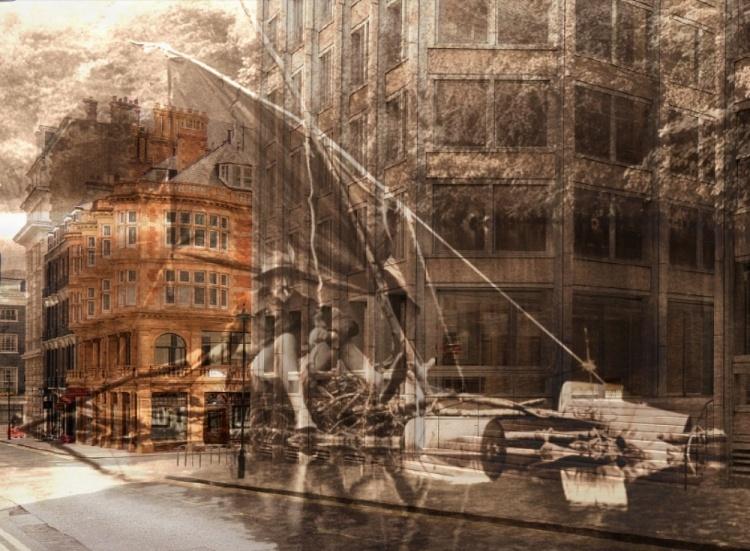
Research Needs You!
Several months ago, I started in earnest to research the life of Millican Dalton. This follows an initial investigation over the past couple of years and I have now visited various Cumbria Archive Centres and the relatives of Mabel M. Barker (friend of Millican) who live in Caldbeck. Having also scoured the libraries of Cumbria and The Fell and Rock Climbing Club of the English Lake District (FRCC) Collection housed at the Armitt Museum & Library in Ambleside, I have collated a small but useful collection of material for analysis. I have extrapolated some of this information in a forensic fashion and begun following up each lead. Some leads have provided results and others have led nowhere. In addition to requests for information in local newspapers, I have also placed posters in various Lake District towns and in the village of Marlow Bottom, Buckinghamshire—which have surprisingly produced some positive findings. With my collection of firsthand accounts, anecdotes and photographs growing, and my interest deepening, my aim is to discover more information. Maybe you can help? If you know the whereabouts of any Millican Dalton related material or can point me in the direction of anyone who knew him personally, please contact me.
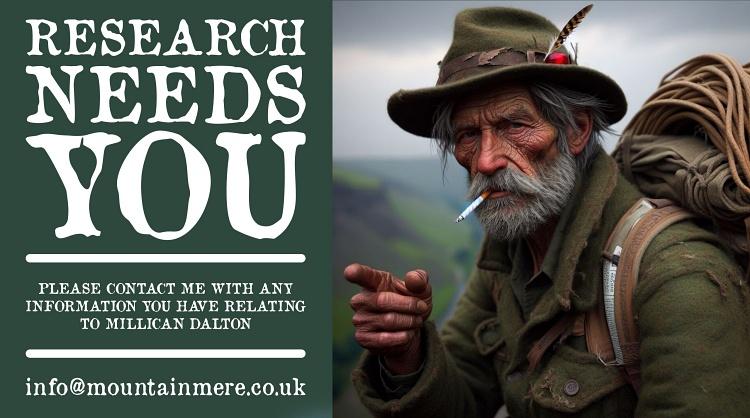
In Search of Millican's Cave
Enthused by the extraordinary story of Millican Dalton and having undertaken further background reading in Cumbria Magazine, Harry Griffin’s The Real Lakeland, and Alan Hankinson’s Century on the Crags, I was compelled to make a visit to Millican’s Cave on Castle Crag; it’s something I have been planning for a while. Last week, along with a friend, we made our way to Borrowdale on a hot sunny morning and on arrival set off from the small car park beside the double bridge at Grange-in-Borrowdale loaded to the hilt with backpacking gear. Full of anticipation, we walked down the treelined lane to Hollow’s Farm where we surveyed the crag from Gowd Dub, the large bend in the river near the campsite. Rather ill prepared, I had left my Wainwright guidebook in the car, but full of youthful exuberance we were confident in finding our destination. “How hard can it be?” I asked.
After a moment of contemplation, a decision was made to follow the Cumbrian Way and then ascend to the summit of Castle Crag. We assessed the landscape on our climb and although there was evidence of large-scale quarrying (the top of Castle Crag is long missing), we noted nothing that resembled a cave entrance. Once on the summit we marvelled at the fine panorama afforded to us by the clear blue skies and stayed a while to bask in the sunshine.
From there we descended the west side of the crag, and then traversed over to the east flank. The steep ground covered in trees and tall, dense bracken made the going hard, especially with the heavy rucksacks. With sweat pouring down our brows we persevered, but finding Millican’s Cave was harder than anticipated, and we had given up all hope of locating it when, down below, we saw a clearing in the trees; a terrace and spoil heaps appeared and lo! behind us was the dark, gaping mouth of the cave. Bingo! On entering the large cavern, we took time to explore the two chambers; there was evidence of previous campers and their campfires; a whiff of woodsmoke lingered in the air. In the upper chamber we discovered Millican’s now famous inscription carved into the cave wall, ‘Don’t waste words, jump to conclusions.’ We took notice of his advice and dispensed with our chit-chat. Hot and bothered, the cool, damp atmosphere of the cave offered relief from the sun’s rays. There was a real sense of calm within the cave despite the sound of the water that streams from the cracks in the ceiling. It was like stepping into another world.
With our goal achieved we headed down to the valley floor for a swim in the crystal clear, cold water of the River Derwent. Lazing under the larch trees listening to birdsong, we lunched on freeze-dried chilli con carne (it may sound unappetising, but it went down a treat!) and then walked further down the valley to pitch camp for the night.
My visit to Millican’s Cave has created more questions than answers, and I am left with an eagerness to learn more about this Lakeland legend. However, little exists in the way of hard facts, so my quest may prove something of a challenge. The cave can be difficult to find unless you have a map, but it is worthy of a visit. Simplistic directions would be to follow the Grange to Rosthwaite path in that direction, and once in the shadow of Castle Crag you will see a fork in the track which is marked by a signpost. Turn right here and carry on upwards between the large slate spoil heaps. A waterlogged cave will appear; ignore this and continue. The track then levels out onto a terrace and the cave will be on the left. Make sure you take a brew kit and a stove so you can trial the life of a modern-day caveman, albeit for an hour or two.
Discovering a Lakeland Legend
I have just learned with interest about a little-known Lakeland legend named Millican Dalton, otherwise known as the Professor of Adventure. My dad, also intrigued, introduced me to Millican’s story after reading Alfred Wainwright’s guidebook The North-Western Fells. According to Wainwright, this eccentric character lived each summer in a large cave on the side of Castle Crag in Borrowdale between the two world wars. Yes, a cave. You read that correctly! I have been visiting the Lake District for years; can someone please explain to me why I have never heard his name before? I have an urge to find out more! If anyone has any information on Millican please contact me.
Image courtesy of the Alfred Wainwright Estate.
